Impact of Staff Motivation on Employee Retention: A Case Study of Hilton Hotel Organization
VerifiedAdded on 2023/06/17
|24
|5891
|144
AI Summary
This research project analyzes the impact of staff motivation schemes to employee retention in Hilton Hotel organization. It covers the understanding of staff motivation, staff motivation strategies for business growth, and evaluation of human resource management strategies.
Contribute Materials
Your contribution can guide someone’s learning journey. Share your
documents today.

RESEARCH PROJECT
1
1
Secure Best Marks with AI Grader
Need help grading? Try our AI Grader for instant feedback on your assignments.
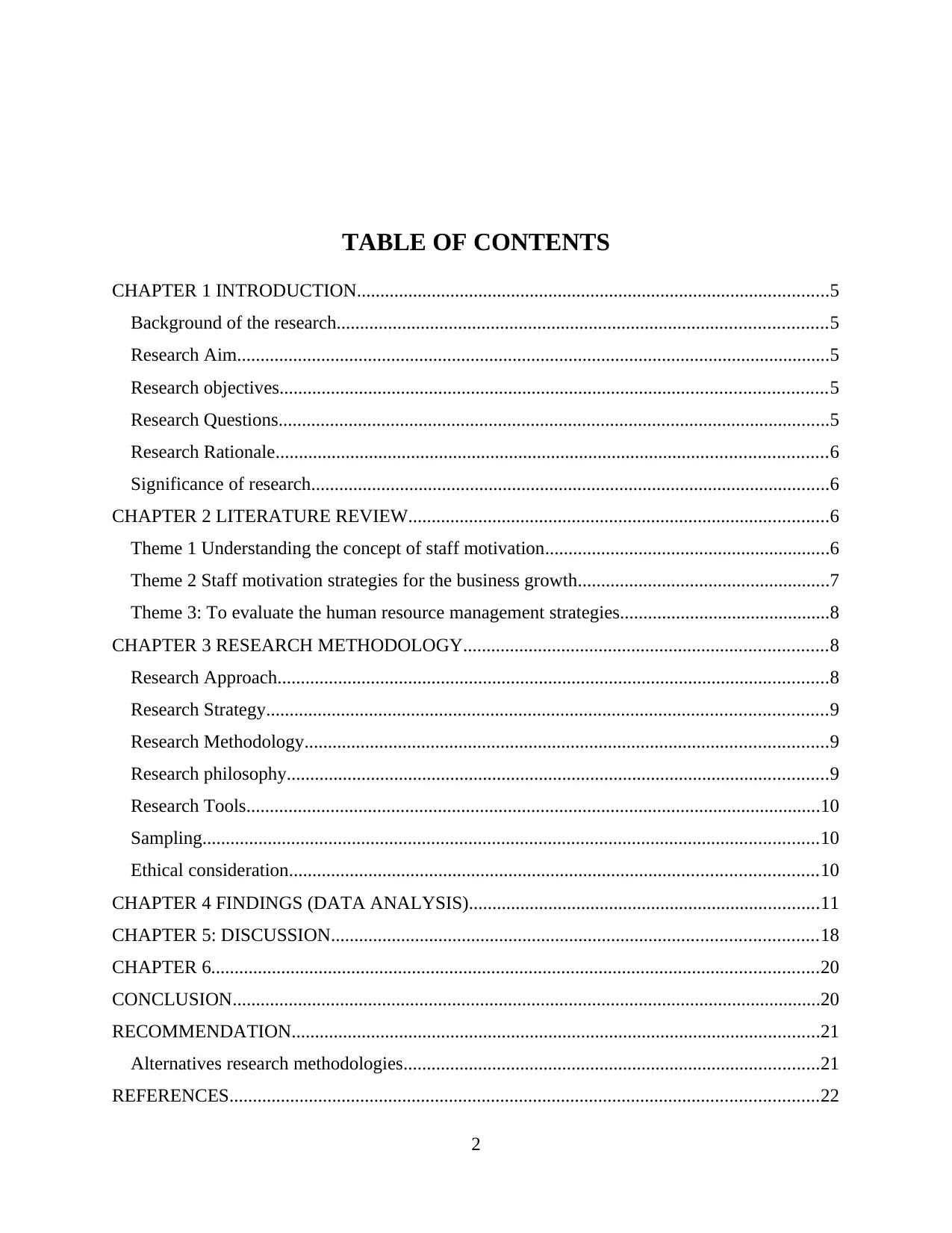
TABLE OF CONTENTS
CHAPTER 1 INTRODUCTION.....................................................................................................5
Background of the research.........................................................................................................5
Research Aim...............................................................................................................................5
Research objectives.....................................................................................................................5
Research Questions......................................................................................................................5
Research Rationale......................................................................................................................6
Significance of research...............................................................................................................6
CHAPTER 2 LITERATURE REVIEW..........................................................................................6
Theme 1 Understanding the concept of staff motivation.............................................................6
Theme 2 Staff motivation strategies for the business growth......................................................7
Theme 3: To evaluate the human resource management strategies.............................................8
CHAPTER 3 RESEARCH METHODOLOGY..............................................................................8
Research Approach......................................................................................................................8
Research Strategy........................................................................................................................9
Research Methodology................................................................................................................9
Research philosophy....................................................................................................................9
Research Tools...........................................................................................................................10
Sampling....................................................................................................................................10
Ethical consideration.................................................................................................................10
CHAPTER 4 FINDINGS (DATA ANALYSIS)...........................................................................11
CHAPTER 5: DISCUSSION........................................................................................................18
CHAPTER 6..................................................................................................................................20
CONCLUSION..............................................................................................................................20
RECOMMENDATION.................................................................................................................21
Alternatives research methodologies.........................................................................................21
REFERENCES..............................................................................................................................22
2
CHAPTER 1 INTRODUCTION.....................................................................................................5
Background of the research.........................................................................................................5
Research Aim...............................................................................................................................5
Research objectives.....................................................................................................................5
Research Questions......................................................................................................................5
Research Rationale......................................................................................................................6
Significance of research...............................................................................................................6
CHAPTER 2 LITERATURE REVIEW..........................................................................................6
Theme 1 Understanding the concept of staff motivation.............................................................6
Theme 2 Staff motivation strategies for the business growth......................................................7
Theme 3: To evaluate the human resource management strategies.............................................8
CHAPTER 3 RESEARCH METHODOLOGY..............................................................................8
Research Approach......................................................................................................................8
Research Strategy........................................................................................................................9
Research Methodology................................................................................................................9
Research philosophy....................................................................................................................9
Research Tools...........................................................................................................................10
Sampling....................................................................................................................................10
Ethical consideration.................................................................................................................10
CHAPTER 4 FINDINGS (DATA ANALYSIS)...........................................................................11
CHAPTER 5: DISCUSSION........................................................................................................18
CHAPTER 6..................................................................................................................................20
CONCLUSION..............................................................................................................................20
RECOMMENDATION.................................................................................................................21
Alternatives research methodologies.........................................................................................21
REFERENCES..............................................................................................................................22
2
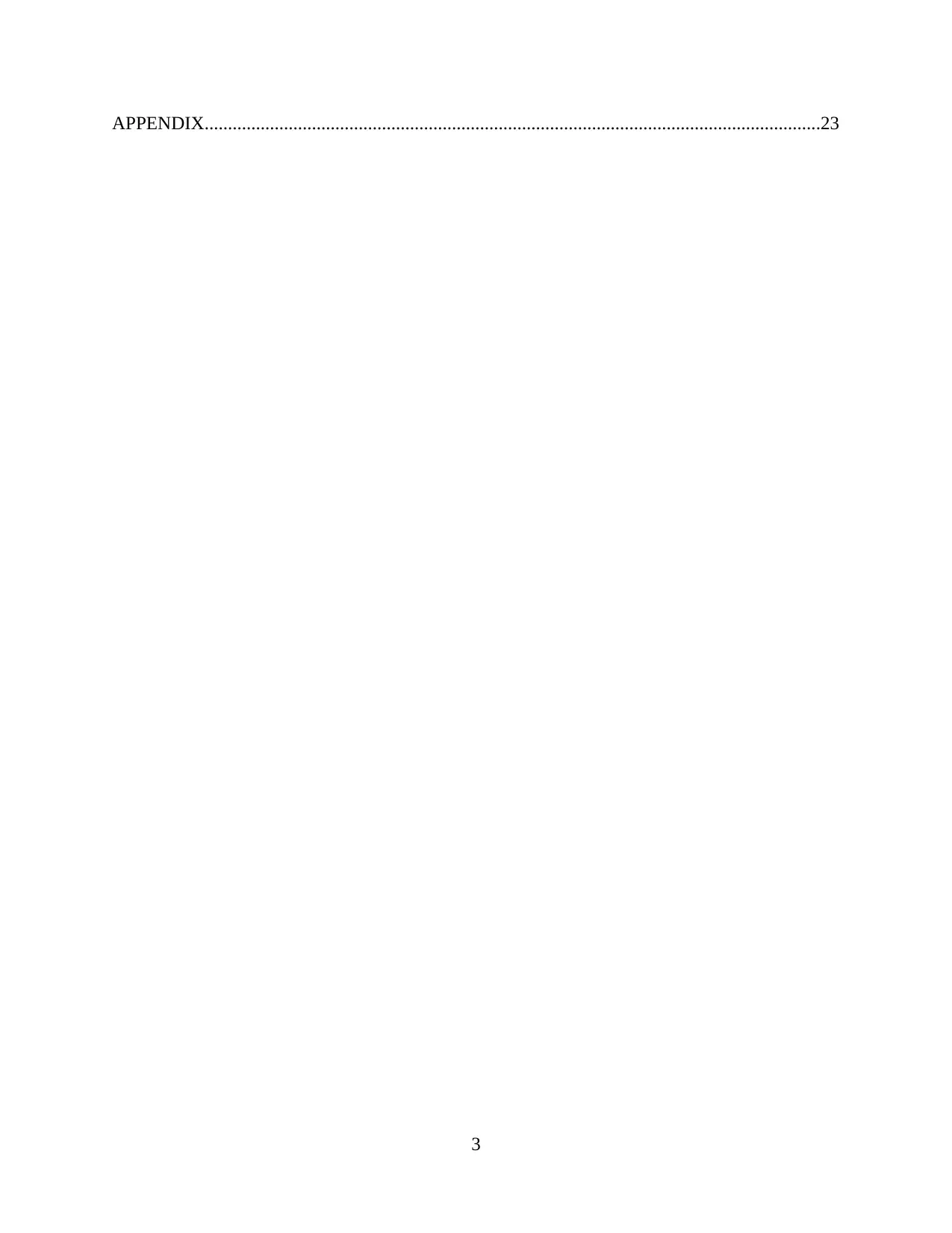
APPENDIX....................................................................................................................................23
3
3
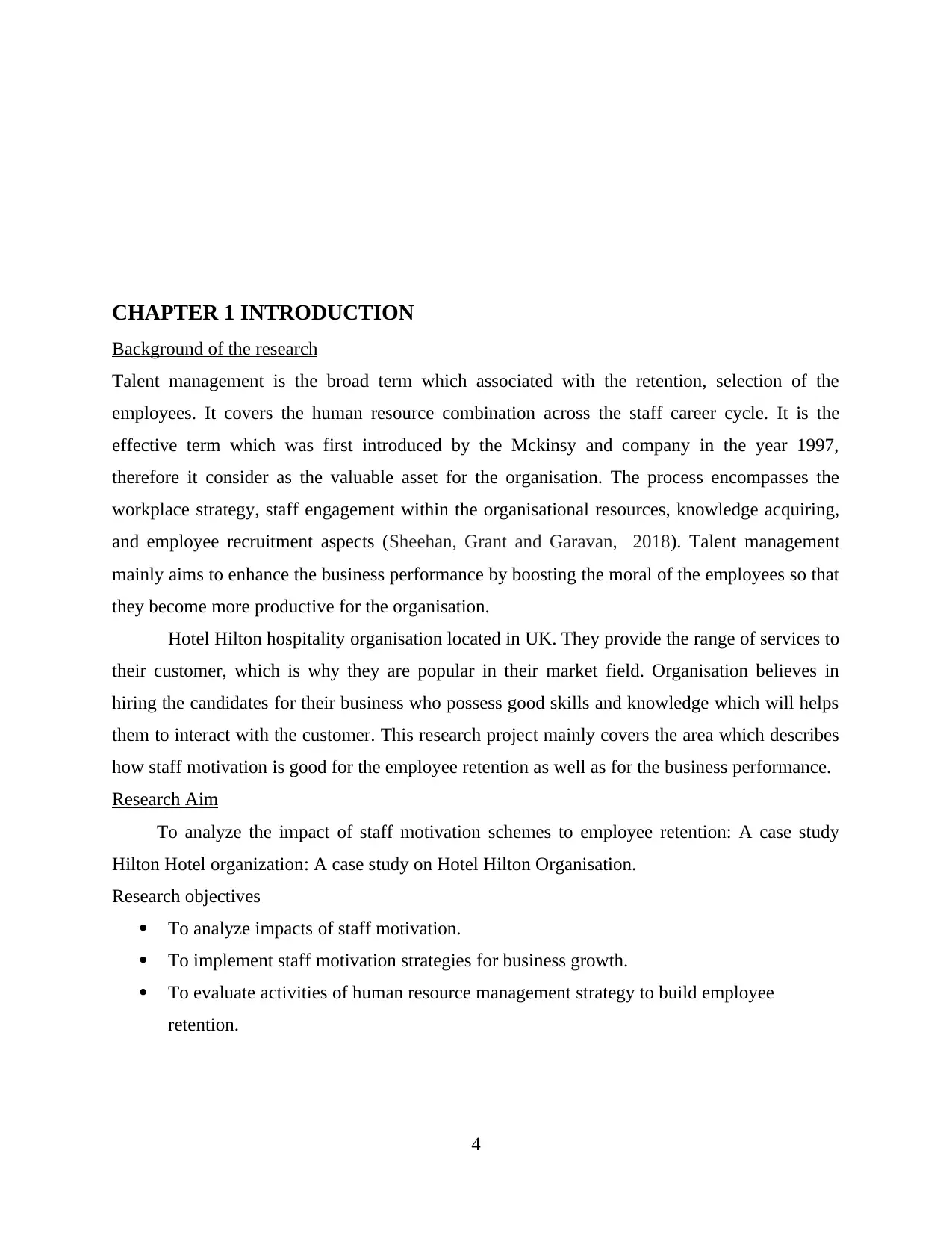
CHAPTER 1 INTRODUCTION
Background of the research
Talent management is the broad term which associated with the retention, selection of the
employees. It covers the human resource combination across the staff career cycle. It is the
effective term which was first introduced by the Mckinsy and company in the year 1997,
therefore it consider as the valuable asset for the organisation. The process encompasses the
workplace strategy, staff engagement within the organisational resources, knowledge acquiring,
and employee recruitment aspects (Sheehan, Grant and Garavan, 2018). Talent management
mainly aims to enhance the business performance by boosting the moral of the employees so that
they become more productive for the organisation.
Hotel Hilton hospitality organisation located in UK. They provide the range of services to
their customer, which is why they are popular in their market field. Organisation believes in
hiring the candidates for their business who possess good skills and knowledge which will helps
them to interact with the customer. This research project mainly covers the area which describes
how staff motivation is good for the employee retention as well as for the business performance.
Research Aim
To analyze the impact of staff motivation schemes to employee retention: A case study
Hilton Hotel organization: A case study on Hotel Hilton Organisation.
Research objectives
To analyze impacts of staff motivation.
To implement staff motivation strategies for business growth.
To evaluate activities of human resource management strategy to build employee
retention.
4
Background of the research
Talent management is the broad term which associated with the retention, selection of the
employees. It covers the human resource combination across the staff career cycle. It is the
effective term which was first introduced by the Mckinsy and company in the year 1997,
therefore it consider as the valuable asset for the organisation. The process encompasses the
workplace strategy, staff engagement within the organisational resources, knowledge acquiring,
and employee recruitment aspects (Sheehan, Grant and Garavan, 2018). Talent management
mainly aims to enhance the business performance by boosting the moral of the employees so that
they become more productive for the organisation.
Hotel Hilton hospitality organisation located in UK. They provide the range of services to
their customer, which is why they are popular in their market field. Organisation believes in
hiring the candidates for their business who possess good skills and knowledge which will helps
them to interact with the customer. This research project mainly covers the area which describes
how staff motivation is good for the employee retention as well as for the business performance.
Research Aim
To analyze the impact of staff motivation schemes to employee retention: A case study
Hilton Hotel organization: A case study on Hotel Hilton Organisation.
Research objectives
To analyze impacts of staff motivation.
To implement staff motivation strategies for business growth.
To evaluate activities of human resource management strategy to build employee
retention.
4
Secure Best Marks with AI Grader
Need help grading? Try our AI Grader for instant feedback on your assignments.
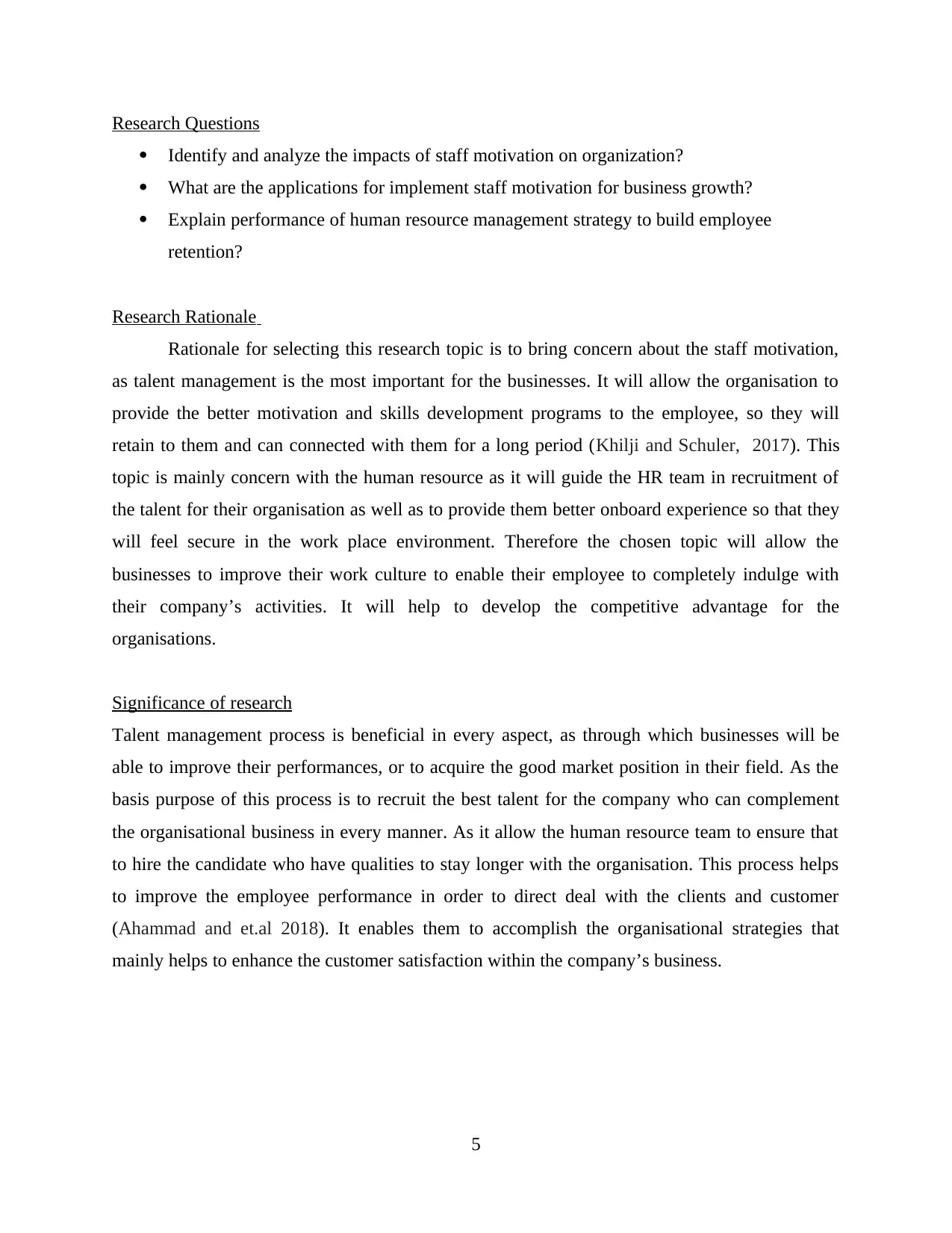
Research Questions
Identify and analyze the impacts of staff motivation on organization?
What are the applications for implement staff motivation for business growth?
Explain performance of human resource management strategy to build employee
retention?
Research Rationale
Rationale for selecting this research topic is to bring concern about the staff motivation,
as talent management is the most important for the businesses. It will allow the organisation to
provide the better motivation and skills development programs to the employee, so they will
retain to them and can connected with them for a long period (Khilji and Schuler, 2017). This
topic is mainly concern with the human resource as it will guide the HR team in recruitment of
the talent for their organisation as well as to provide them better onboard experience so that they
will feel secure in the work place environment. Therefore the chosen topic will allow the
businesses to improve their work culture to enable their employee to completely indulge with
their company’s activities. It will help to develop the competitive advantage for the
organisations.
Significance of research
Talent management process is beneficial in every aspect, as through which businesses will be
able to improve their performances, or to acquire the good market position in their field. As the
basis purpose of this process is to recruit the best talent for the company who can complement
the organisational business in every manner. As it allow the human resource team to ensure that
to hire the candidate who have qualities to stay longer with the organisation. This process helps
to improve the employee performance in order to direct deal with the clients and customer
(Ahammad and et.al 2018). It enables them to accomplish the organisational strategies that
mainly helps to enhance the customer satisfaction within the company’s business.
5
Identify and analyze the impacts of staff motivation on organization?
What are the applications for implement staff motivation for business growth?
Explain performance of human resource management strategy to build employee
retention?
Research Rationale
Rationale for selecting this research topic is to bring concern about the staff motivation,
as talent management is the most important for the businesses. It will allow the organisation to
provide the better motivation and skills development programs to the employee, so they will
retain to them and can connected with them for a long period (Khilji and Schuler, 2017). This
topic is mainly concern with the human resource as it will guide the HR team in recruitment of
the talent for their organisation as well as to provide them better onboard experience so that they
will feel secure in the work place environment. Therefore the chosen topic will allow the
businesses to improve their work culture to enable their employee to completely indulge with
their company’s activities. It will help to develop the competitive advantage for the
organisations.
Significance of research
Talent management process is beneficial in every aspect, as through which businesses will be
able to improve their performances, or to acquire the good market position in their field. As the
basis purpose of this process is to recruit the best talent for the company who can complement
the organisational business in every manner. As it allow the human resource team to ensure that
to hire the candidate who have qualities to stay longer with the organisation. This process helps
to improve the employee performance in order to direct deal with the clients and customer
(Ahammad and et.al 2018). It enables them to accomplish the organisational strategies that
mainly helps to enhance the customer satisfaction within the company’s business.
5
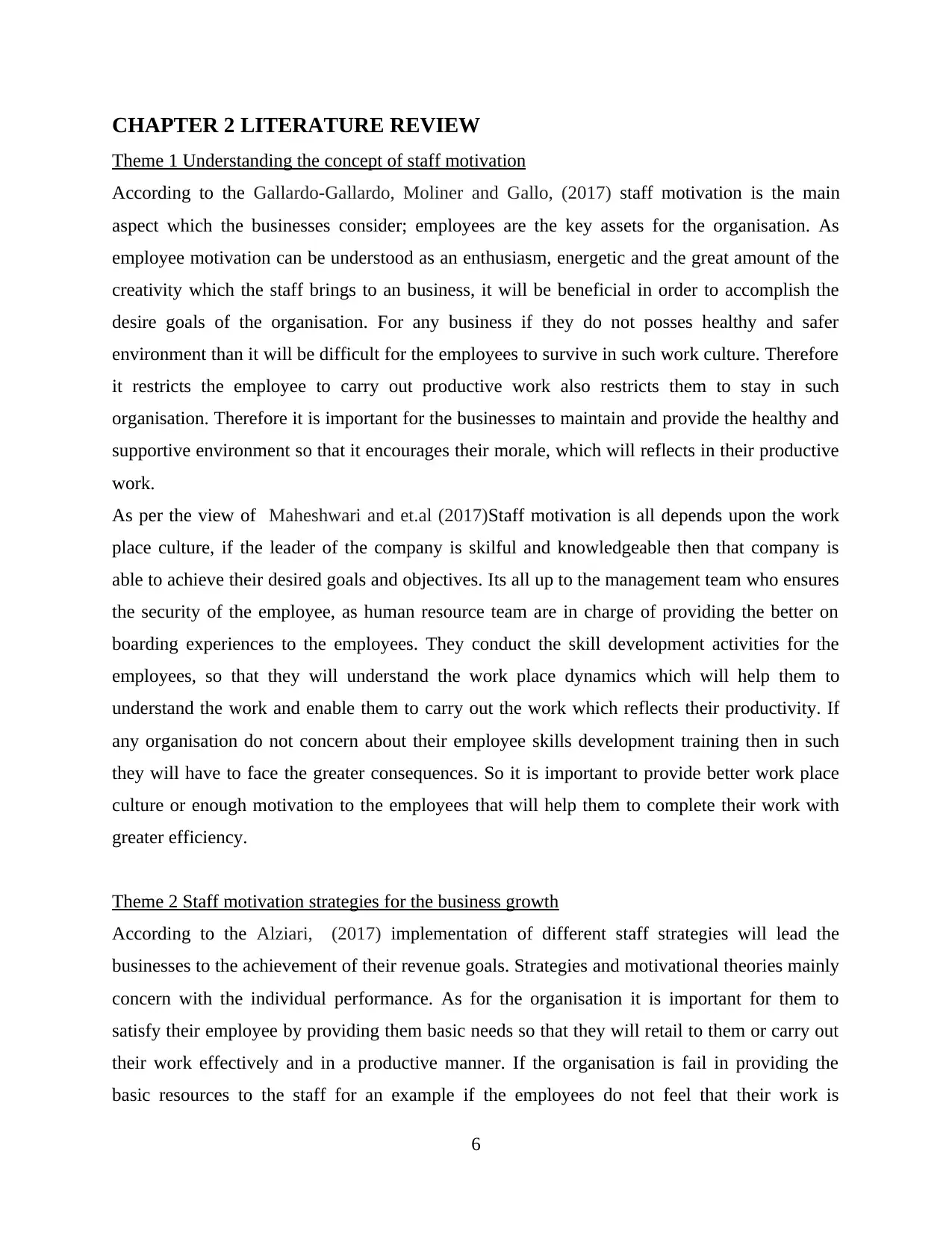
CHAPTER 2 LITERATURE REVIEW
Theme 1 Understanding the concept of staff motivation
According to the Gallardo-Gallardo, Moliner and Gallo, (2017) staff motivation is the main
aspect which the businesses consider; employees are the key assets for the organisation. As
employee motivation can be understood as an enthusiasm, energetic and the great amount of the
creativity which the staff brings to an business, it will be beneficial in order to accomplish the
desire goals of the organisation. For any business if they do not posses healthy and safer
environment than it will be difficult for the employees to survive in such work culture. Therefore
it restricts the employee to carry out productive work also restricts them to stay in such
organisation. Therefore it is important for the businesses to maintain and provide the healthy and
supportive environment so that it encourages their morale, which will reflects in their productive
work.
As per the view of Maheshwari and et.al (2017)Staff motivation is all depends upon the work
place culture, if the leader of the company is skilful and knowledgeable then that company is
able to achieve their desired goals and objectives. Its all up to the management team who ensures
the security of the employee, as human resource team are in charge of providing the better on
boarding experiences to the employees. They conduct the skill development activities for the
employees, so that they will understand the work place dynamics which will help them to
understand the work and enable them to carry out the work which reflects their productivity. If
any organisation do not concern about their employee skills development training then in such
they will have to face the greater consequences. So it is important to provide better work place
culture or enough motivation to the employees that will help them to complete their work with
greater efficiency.
Theme 2 Staff motivation strategies for the business growth
According to the Alziari, (2017) implementation of different staff strategies will lead the
businesses to the achievement of their revenue goals. Strategies and motivational theories mainly
concern with the individual performance. As for the organisation it is important for them to
satisfy their employee by providing them basic needs so that they will retail to them or carry out
their work effectively and in a productive manner. If the organisation is fail in providing the
basic resources to the staff for an example if the employees do not feel that their work is
6
Theme 1 Understanding the concept of staff motivation
According to the Gallardo-Gallardo, Moliner and Gallo, (2017) staff motivation is the main
aspect which the businesses consider; employees are the key assets for the organisation. As
employee motivation can be understood as an enthusiasm, energetic and the great amount of the
creativity which the staff brings to an business, it will be beneficial in order to accomplish the
desire goals of the organisation. For any business if they do not posses healthy and safer
environment than it will be difficult for the employees to survive in such work culture. Therefore
it restricts the employee to carry out productive work also restricts them to stay in such
organisation. Therefore it is important for the businesses to maintain and provide the healthy and
supportive environment so that it encourages their morale, which will reflects in their productive
work.
As per the view of Maheshwari and et.al (2017)Staff motivation is all depends upon the work
place culture, if the leader of the company is skilful and knowledgeable then that company is
able to achieve their desired goals and objectives. Its all up to the management team who ensures
the security of the employee, as human resource team are in charge of providing the better on
boarding experiences to the employees. They conduct the skill development activities for the
employees, so that they will understand the work place dynamics which will help them to
understand the work and enable them to carry out the work which reflects their productivity. If
any organisation do not concern about their employee skills development training then in such
they will have to face the greater consequences. So it is important to provide better work place
culture or enough motivation to the employees that will help them to complete their work with
greater efficiency.
Theme 2 Staff motivation strategies for the business growth
According to the Alziari, (2017) implementation of different staff strategies will lead the
businesses to the achievement of their revenue goals. Strategies and motivational theories mainly
concern with the individual performance. As for the organisation it is important for them to
satisfy their employee by providing them basic needs so that they will retail to them or carry out
their work effectively and in a productive manner. If the organisation is fail in providing the
basic resources to the staff for an example if the employees do not feel that their work is
6
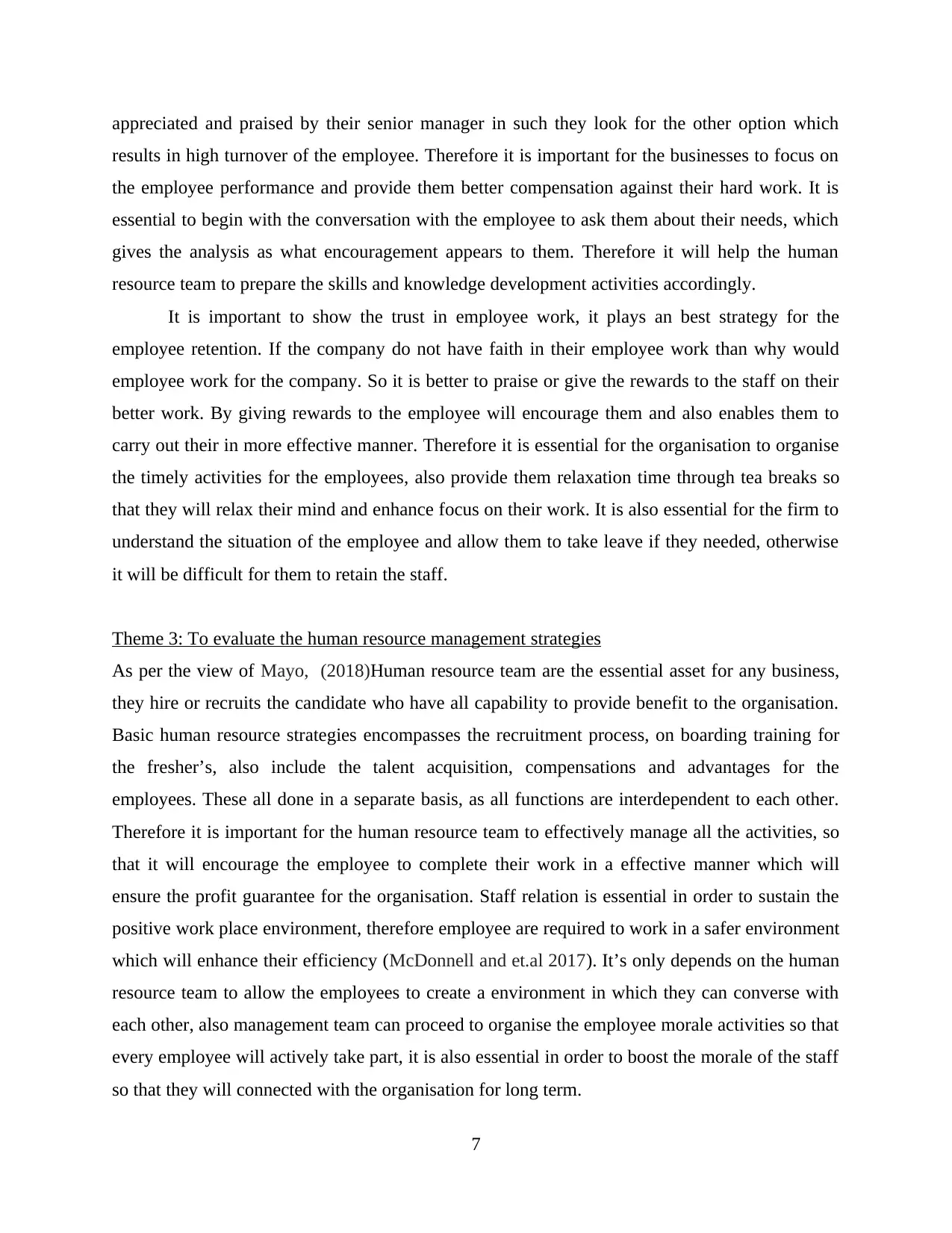
appreciated and praised by their senior manager in such they look for the other option which
results in high turnover of the employee. Therefore it is important for the businesses to focus on
the employee performance and provide them better compensation against their hard work. It is
essential to begin with the conversation with the employee to ask them about their needs, which
gives the analysis as what encouragement appears to them. Therefore it will help the human
resource team to prepare the skills and knowledge development activities accordingly.
It is important to show the trust in employee work, it plays an best strategy for the
employee retention. If the company do not have faith in their employee work than why would
employee work for the company. So it is better to praise or give the rewards to the staff on their
better work. By giving rewards to the employee will encourage them and also enables them to
carry out their in more effective manner. Therefore it is essential for the organisation to organise
the timely activities for the employees, also provide them relaxation time through tea breaks so
that they will relax their mind and enhance focus on their work. It is also essential for the firm to
understand the situation of the employee and allow them to take leave if they needed, otherwise
it will be difficult for them to retain the staff.
Theme 3: To evaluate the human resource management strategies
As per the view of Mayo, (2018)Human resource team are the essential asset for any business,
they hire or recruits the candidate who have all capability to provide benefit to the organisation.
Basic human resource strategies encompasses the recruitment process, on boarding training for
the fresher’s, also include the talent acquisition, compensations and advantages for the
employees. These all done in a separate basis, as all functions are interdependent to each other.
Therefore it is important for the human resource team to effectively manage all the activities, so
that it will encourage the employee to complete their work in a effective manner which will
ensure the profit guarantee for the organisation. Staff relation is essential in order to sustain the
positive work place environment, therefore employee are required to work in a safer environment
which will enhance their efficiency (McDonnell and et.al 2017). It’s only depends on the human
resource team to allow the employees to create a environment in which they can converse with
each other, also management team can proceed to organise the employee morale activities so that
every employee will actively take part, it is also essential in order to boost the morale of the staff
so that they will connected with the organisation for long term.
7
results in high turnover of the employee. Therefore it is important for the businesses to focus on
the employee performance and provide them better compensation against their hard work. It is
essential to begin with the conversation with the employee to ask them about their needs, which
gives the analysis as what encouragement appears to them. Therefore it will help the human
resource team to prepare the skills and knowledge development activities accordingly.
It is important to show the trust in employee work, it plays an best strategy for the
employee retention. If the company do not have faith in their employee work than why would
employee work for the company. So it is better to praise or give the rewards to the staff on their
better work. By giving rewards to the employee will encourage them and also enables them to
carry out their in more effective manner. Therefore it is essential for the organisation to organise
the timely activities for the employees, also provide them relaxation time through tea breaks so
that they will relax their mind and enhance focus on their work. It is also essential for the firm to
understand the situation of the employee and allow them to take leave if they needed, otherwise
it will be difficult for them to retain the staff.
Theme 3: To evaluate the human resource management strategies
As per the view of Mayo, (2018)Human resource team are the essential asset for any business,
they hire or recruits the candidate who have all capability to provide benefit to the organisation.
Basic human resource strategies encompasses the recruitment process, on boarding training for
the fresher’s, also include the talent acquisition, compensations and advantages for the
employees. These all done in a separate basis, as all functions are interdependent to each other.
Therefore it is important for the human resource team to effectively manage all the activities, so
that it will encourage the employee to complete their work in a effective manner which will
ensure the profit guarantee for the organisation. Staff relation is essential in order to sustain the
positive work place environment, therefore employee are required to work in a safer environment
which will enhance their efficiency (McDonnell and et.al 2017). It’s only depends on the human
resource team to allow the employees to create a environment in which they can converse with
each other, also management team can proceed to organise the employee morale activities so that
every employee will actively take part, it is also essential in order to boost the morale of the staff
so that they will connected with the organisation for long term.
7
Paraphrase This Document
Need a fresh take? Get an instant paraphrase of this document with our AI Paraphraser
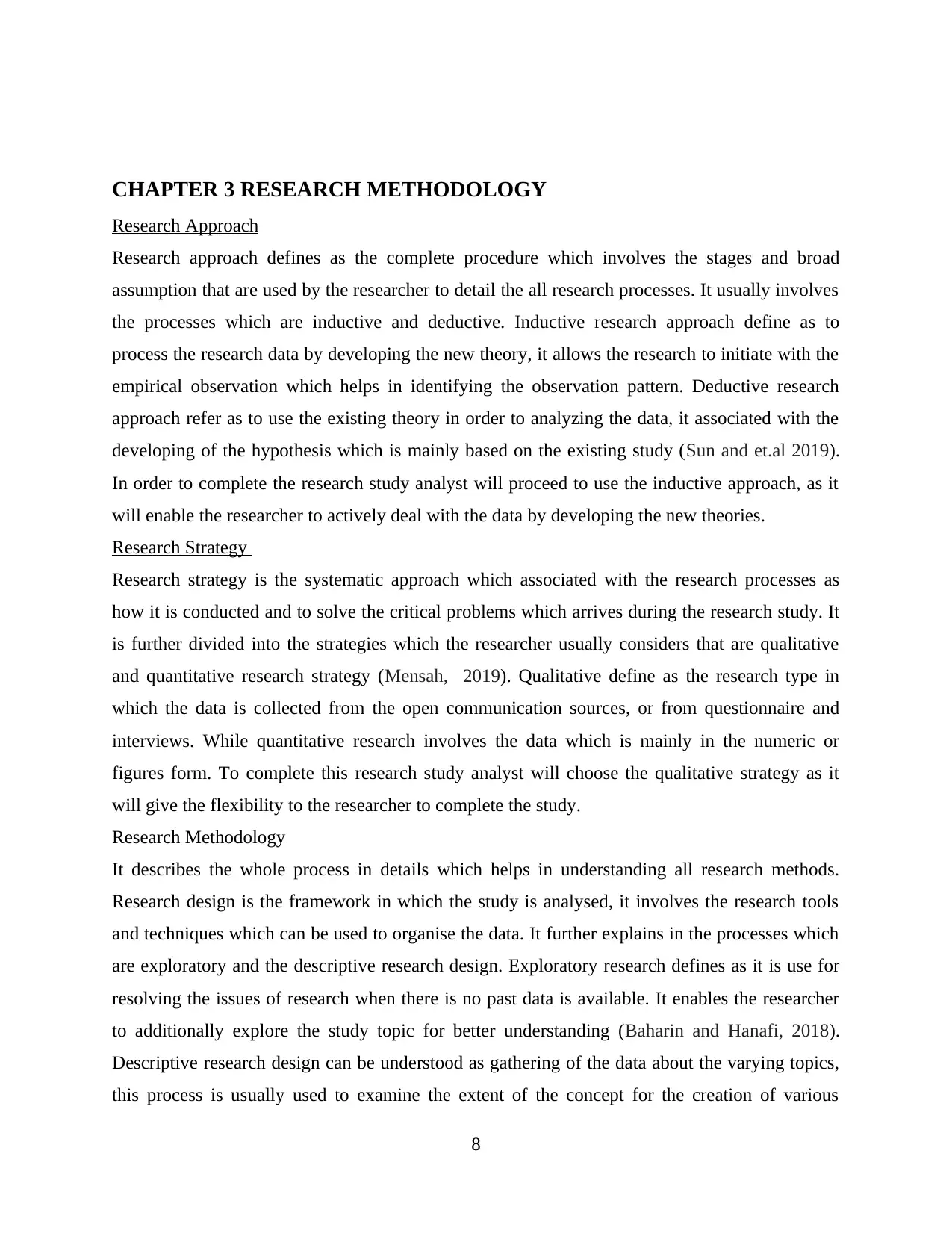
CHAPTER 3 RESEARCH METHODOLOGY
Research Approach
Research approach defines as the complete procedure which involves the stages and broad
assumption that are used by the researcher to detail the all research processes. It usually involves
the processes which are inductive and deductive. Inductive research approach define as to
process the research data by developing the new theory, it allows the research to initiate with the
empirical observation which helps in identifying the observation pattern. Deductive research
approach refer as to use the existing theory in order to analyzing the data, it associated with the
developing of the hypothesis which is mainly based on the existing study (Sun and et.al 2019).
In order to complete the research study analyst will proceed to use the inductive approach, as it
will enable the researcher to actively deal with the data by developing the new theories.
Research Strategy
Research strategy is the systematic approach which associated with the research processes as
how it is conducted and to solve the critical problems which arrives during the research study. It
is further divided into the strategies which the researcher usually considers that are qualitative
and quantitative research strategy (Mensah, 2019). Qualitative define as the research type in
which the data is collected from the open communication sources, or from questionnaire and
interviews. While quantitative research involves the data which is mainly in the numeric or
figures form. To complete this research study analyst will choose the qualitative strategy as it
will give the flexibility to the researcher to complete the study.
Research Methodology
It describes the whole process in details which helps in understanding all research methods.
Research design is the framework in which the study is analysed, it involves the research tools
and techniques which can be used to organise the data. It further explains in the processes which
are exploratory and the descriptive research design. Exploratory research defines as it is use for
resolving the issues of research when there is no past data is available. It enables the researcher
to additionally explore the study topic for better understanding (Baharin and Hanafi, 2018).
Descriptive research design can be understood as gathering of the data about the varying topics,
this process is usually used to examine the extent of the concept for the creation of various
8
Research Approach
Research approach defines as the complete procedure which involves the stages and broad
assumption that are used by the researcher to detail the all research processes. It usually involves
the processes which are inductive and deductive. Inductive research approach define as to
process the research data by developing the new theory, it allows the research to initiate with the
empirical observation which helps in identifying the observation pattern. Deductive research
approach refer as to use the existing theory in order to analyzing the data, it associated with the
developing of the hypothesis which is mainly based on the existing study (Sun and et.al 2019).
In order to complete the research study analyst will proceed to use the inductive approach, as it
will enable the researcher to actively deal with the data by developing the new theories.
Research Strategy
Research strategy is the systematic approach which associated with the research processes as
how it is conducted and to solve the critical problems which arrives during the research study. It
is further divided into the strategies which the researcher usually considers that are qualitative
and quantitative research strategy (Mensah, 2019). Qualitative define as the research type in
which the data is collected from the open communication sources, or from questionnaire and
interviews. While quantitative research involves the data which is mainly in the numeric or
figures form. To complete this research study analyst will choose the qualitative strategy as it
will give the flexibility to the researcher to complete the study.
Research Methodology
It describes the whole process in details which helps in understanding all research methods.
Research design is the framework in which the study is analysed, it involves the research tools
and techniques which can be used to organise the data. It further explains in the processes which
are exploratory and the descriptive research design. Exploratory research defines as it is use for
resolving the issues of research when there is no past data is available. It enables the researcher
to additionally explore the study topic for better understanding (Baharin and Hanafi, 2018).
Descriptive research design can be understood as gathering of the data about the varying topics,
this process is usually used to examine the extent of the concept for the creation of various
8
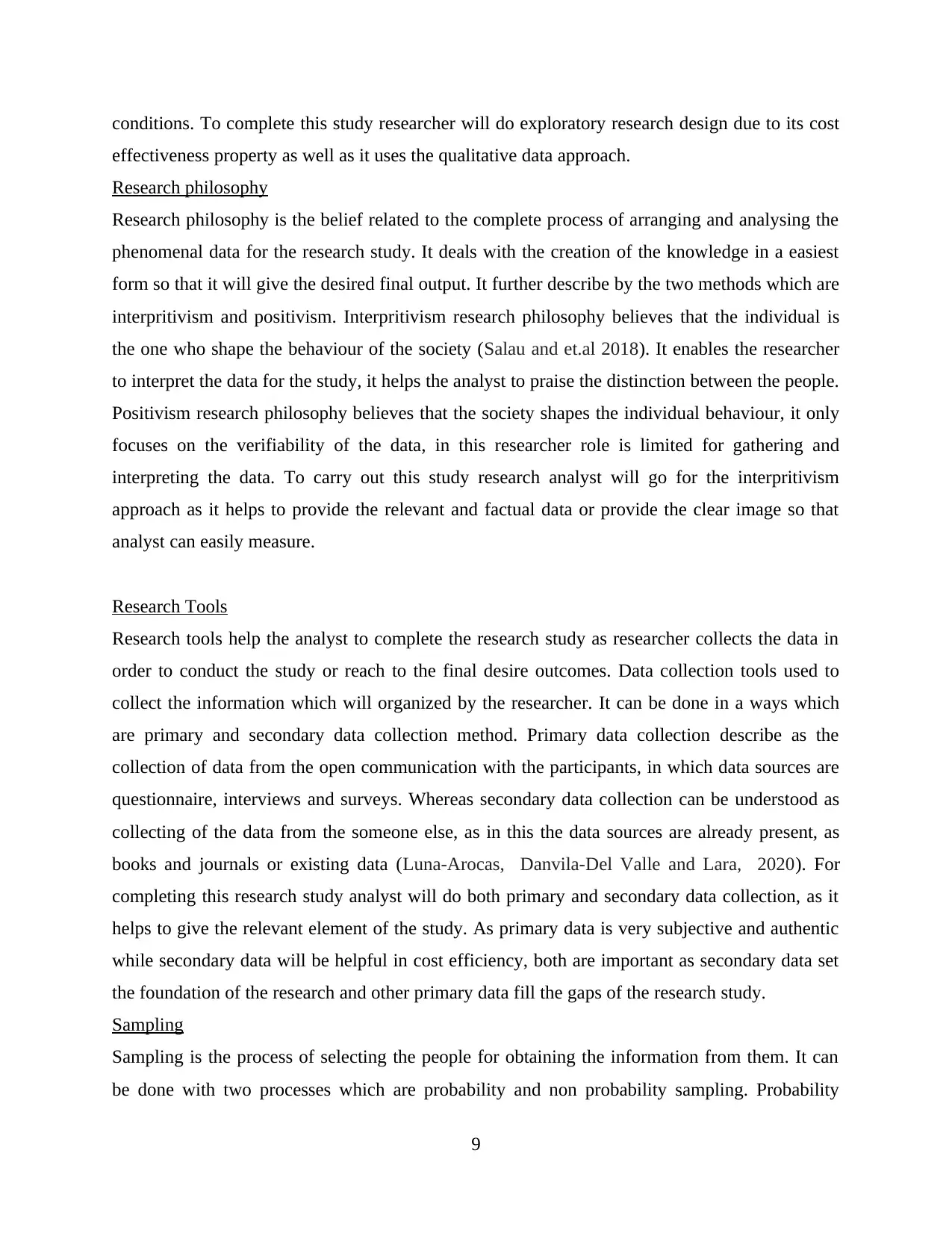
conditions. To complete this study researcher will do exploratory research design due to its cost
effectiveness property as well as it uses the qualitative data approach.
Research philosophy
Research philosophy is the belief related to the complete process of arranging and analysing the
phenomenal data for the research study. It deals with the creation of the knowledge in a easiest
form so that it will give the desired final output. It further describe by the two methods which are
interpritivism and positivism. Interpritivism research philosophy believes that the individual is
the one who shape the behaviour of the society (Salau and et.al 2018). It enables the researcher
to interpret the data for the study, it helps the analyst to praise the distinction between the people.
Positivism research philosophy believes that the society shapes the individual behaviour, it only
focuses on the verifiability of the data, in this researcher role is limited for gathering and
interpreting the data. To carry out this study research analyst will go for the interpritivism
approach as it helps to provide the relevant and factual data or provide the clear image so that
analyst can easily measure.
Research Tools
Research tools help the analyst to complete the research study as researcher collects the data in
order to conduct the study or reach to the final desire outcomes. Data collection tools used to
collect the information which will organized by the researcher. It can be done in a ways which
are primary and secondary data collection method. Primary data collection describe as the
collection of data from the open communication with the participants, in which data sources are
questionnaire, interviews and surveys. Whereas secondary data collection can be understood as
collecting of the data from the someone else, as in this the data sources are already present, as
books and journals or existing data (Luna-Arocas, Danvila-Del Valle and Lara, 2020). For
completing this research study analyst will do both primary and secondary data collection, as it
helps to give the relevant element of the study. As primary data is very subjective and authentic
while secondary data will be helpful in cost efficiency, both are important as secondary data set
the foundation of the research and other primary data fill the gaps of the research study.
Sampling
Sampling is the process of selecting the people for obtaining the information from them. It can
be done with two processes which are probability and non probability sampling. Probability
9
effectiveness property as well as it uses the qualitative data approach.
Research philosophy
Research philosophy is the belief related to the complete process of arranging and analysing the
phenomenal data for the research study. It deals with the creation of the knowledge in a easiest
form so that it will give the desired final output. It further describe by the two methods which are
interpritivism and positivism. Interpritivism research philosophy believes that the individual is
the one who shape the behaviour of the society (Salau and et.al 2018). It enables the researcher
to interpret the data for the study, it helps the analyst to praise the distinction between the people.
Positivism research philosophy believes that the society shapes the individual behaviour, it only
focuses on the verifiability of the data, in this researcher role is limited for gathering and
interpreting the data. To carry out this study research analyst will go for the interpritivism
approach as it helps to provide the relevant and factual data or provide the clear image so that
analyst can easily measure.
Research Tools
Research tools help the analyst to complete the research study as researcher collects the data in
order to conduct the study or reach to the final desire outcomes. Data collection tools used to
collect the information which will organized by the researcher. It can be done in a ways which
are primary and secondary data collection method. Primary data collection describe as the
collection of data from the open communication with the participants, in which data sources are
questionnaire, interviews and surveys. Whereas secondary data collection can be understood as
collecting of the data from the someone else, as in this the data sources are already present, as
books and journals or existing data (Luna-Arocas, Danvila-Del Valle and Lara, 2020). For
completing this research study analyst will do both primary and secondary data collection, as it
helps to give the relevant element of the study. As primary data is very subjective and authentic
while secondary data will be helpful in cost efficiency, both are important as secondary data set
the foundation of the research and other primary data fill the gaps of the research study.
Sampling
Sampling is the process of selecting the people for obtaining the information from them. It can
be done with two processes which are probability and non probability sampling. Probability
9
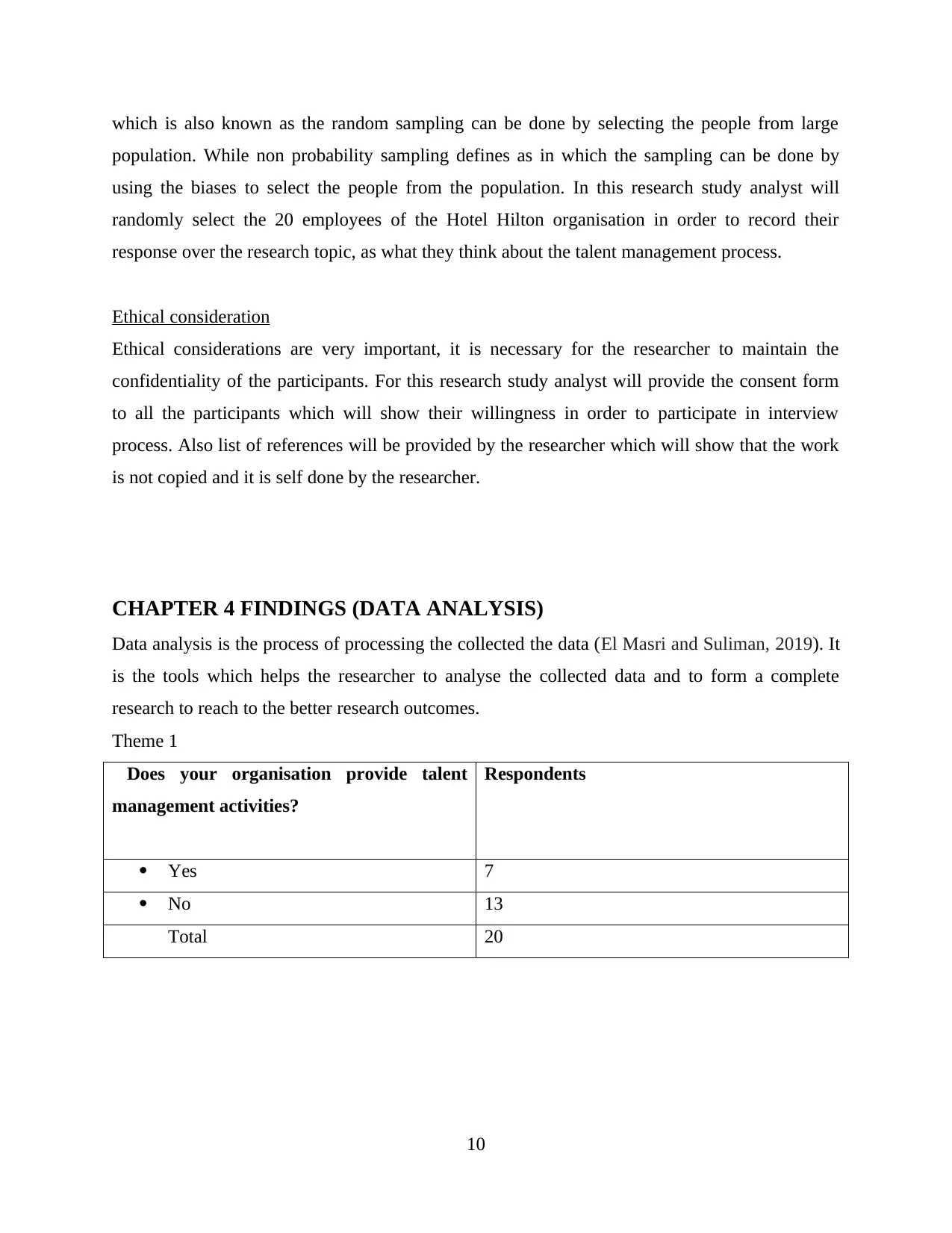
which is also known as the random sampling can be done by selecting the people from large
population. While non probability sampling defines as in which the sampling can be done by
using the biases to select the people from the population. In this research study analyst will
randomly select the 20 employees of the Hotel Hilton organisation in order to record their
response over the research topic, as what they think about the talent management process.
Ethical consideration
Ethical considerations are very important, it is necessary for the researcher to maintain the
confidentiality of the participants. For this research study analyst will provide the consent form
to all the participants which will show their willingness in order to participate in interview
process. Also list of references will be provided by the researcher which will show that the work
is not copied and it is self done by the researcher.
CHAPTER 4 FINDINGS (DATA ANALYSIS)
Data analysis is the process of processing the collected the data (El Masri and Suliman, 2019). It
is the tools which helps the researcher to analyse the collected data and to form a complete
research to reach to the better research outcomes.
Theme 1
Does your organisation provide talent
management activities?
Respondents
Yes 7
No 13
Total 20
10
population. While non probability sampling defines as in which the sampling can be done by
using the biases to select the people from the population. In this research study analyst will
randomly select the 20 employees of the Hotel Hilton organisation in order to record their
response over the research topic, as what they think about the talent management process.
Ethical consideration
Ethical considerations are very important, it is necessary for the researcher to maintain the
confidentiality of the participants. For this research study analyst will provide the consent form
to all the participants which will show their willingness in order to participate in interview
process. Also list of references will be provided by the researcher which will show that the work
is not copied and it is self done by the researcher.
CHAPTER 4 FINDINGS (DATA ANALYSIS)
Data analysis is the process of processing the collected the data (El Masri and Suliman, 2019). It
is the tools which helps the researcher to analyse the collected data and to form a complete
research to reach to the better research outcomes.
Theme 1
Does your organisation provide talent
management activities?
Respondents
Yes 7
No 13
Total 20
10
Secure Best Marks with AI Grader
Need help grading? Try our AI Grader for instant feedback on your assignments.
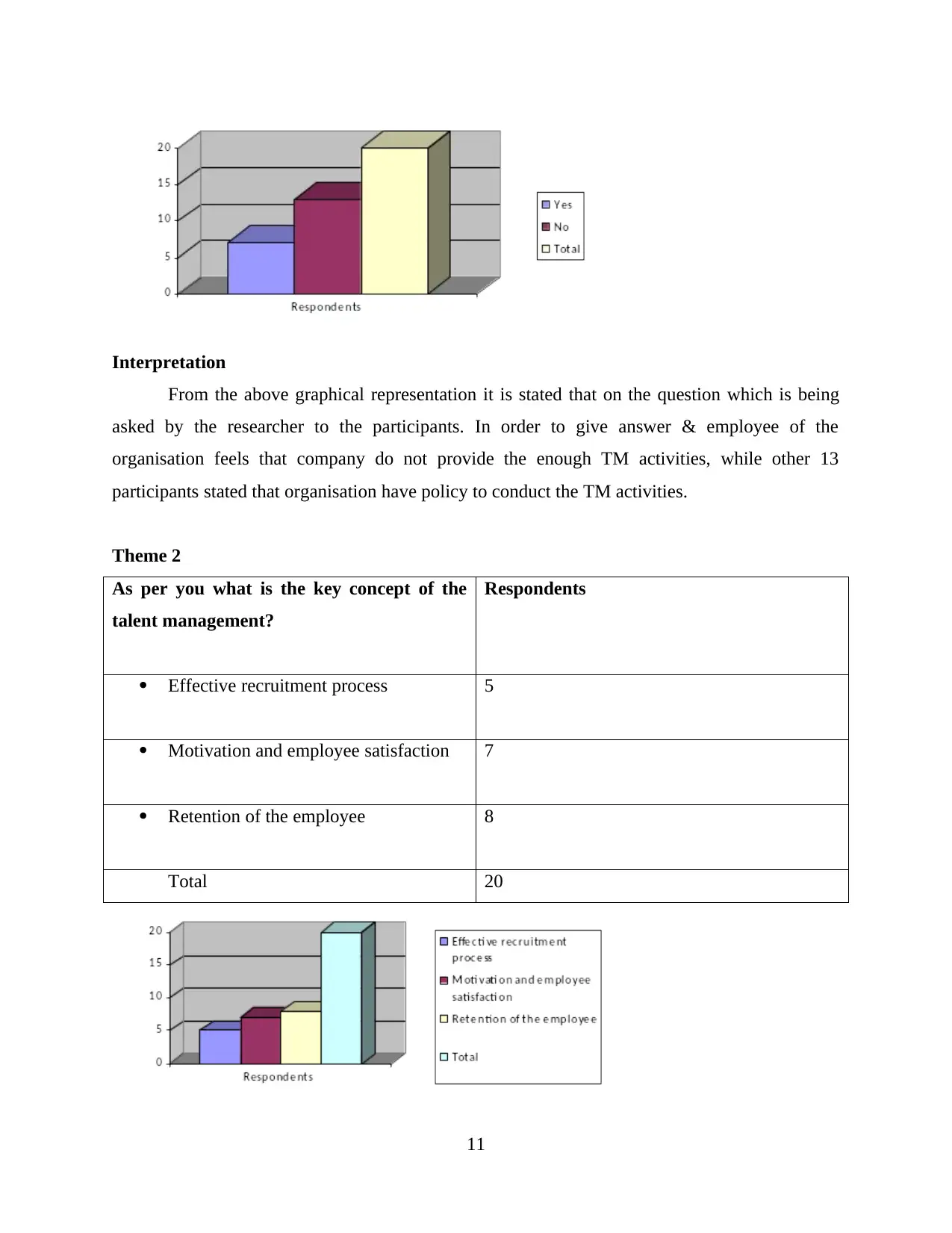
Interpretation
From the above graphical representation it is stated that on the question which is being
asked by the researcher to the participants. In order to give answer & employee of the
organisation feels that company do not provide the enough TM activities, while other 13
participants stated that organisation have policy to conduct the TM activities.
Theme 2
As per you what is the key concept of the
talent management?
Respondents
Effective recruitment process 5
Motivation and employee satisfaction 7
Retention of the employee 8
Total 20
11
From the above graphical representation it is stated that on the question which is being
asked by the researcher to the participants. In order to give answer & employee of the
organisation feels that company do not provide the enough TM activities, while other 13
participants stated that organisation have policy to conduct the TM activities.
Theme 2
As per you what is the key concept of the
talent management?
Respondents
Effective recruitment process 5
Motivation and employee satisfaction 7
Retention of the employee 8
Total 20
11
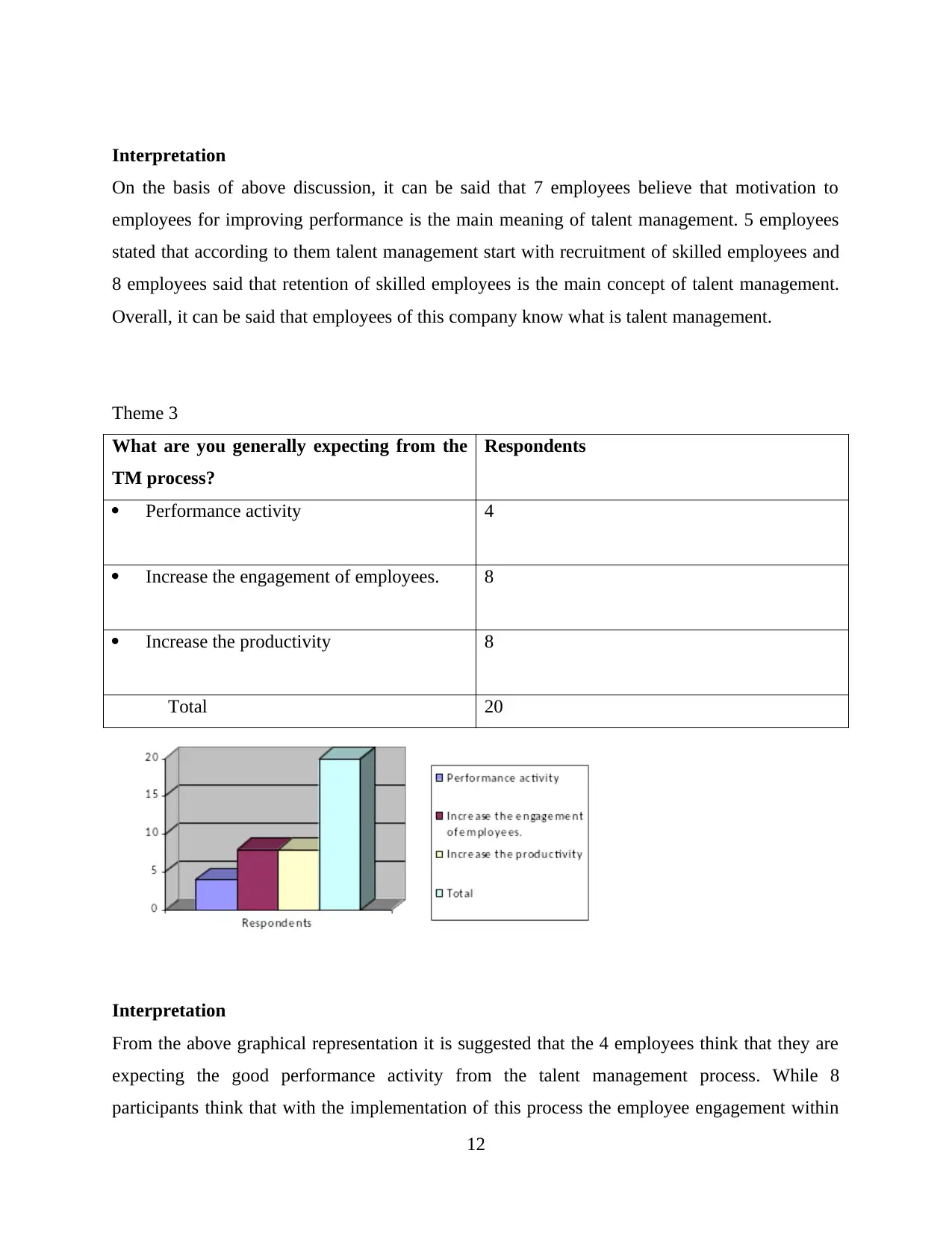
Interpretation
On the basis of above discussion, it can be said that 7 employees believe that motivation to
employees for improving performance is the main meaning of talent management. 5 employees
stated that according to them talent management start with recruitment of skilled employees and
8 employees said that retention of skilled employees is the main concept of talent management.
Overall, it can be said that employees of this company know what is talent management.
Theme 3
What are you generally expecting from the
TM process?
Respondents
Performance activity 4
Increase the engagement of employees. 8
Increase the productivity 8
Total 20
Interpretation
From the above graphical representation it is suggested that the 4 employees think that they are
expecting the good performance activity from the talent management process. While 8
participants think that with the implementation of this process the employee engagement within
12
On the basis of above discussion, it can be said that 7 employees believe that motivation to
employees for improving performance is the main meaning of talent management. 5 employees
stated that according to them talent management start with recruitment of skilled employees and
8 employees said that retention of skilled employees is the main concept of talent management.
Overall, it can be said that employees of this company know what is talent management.
Theme 3
What are you generally expecting from the
TM process?
Respondents
Performance activity 4
Increase the engagement of employees. 8
Increase the productivity 8
Total 20
Interpretation
From the above graphical representation it is suggested that the 4 employees think that they are
expecting the good performance activity from the talent management process. While 8
participants think that with the implementation of this process the employee engagement within
12
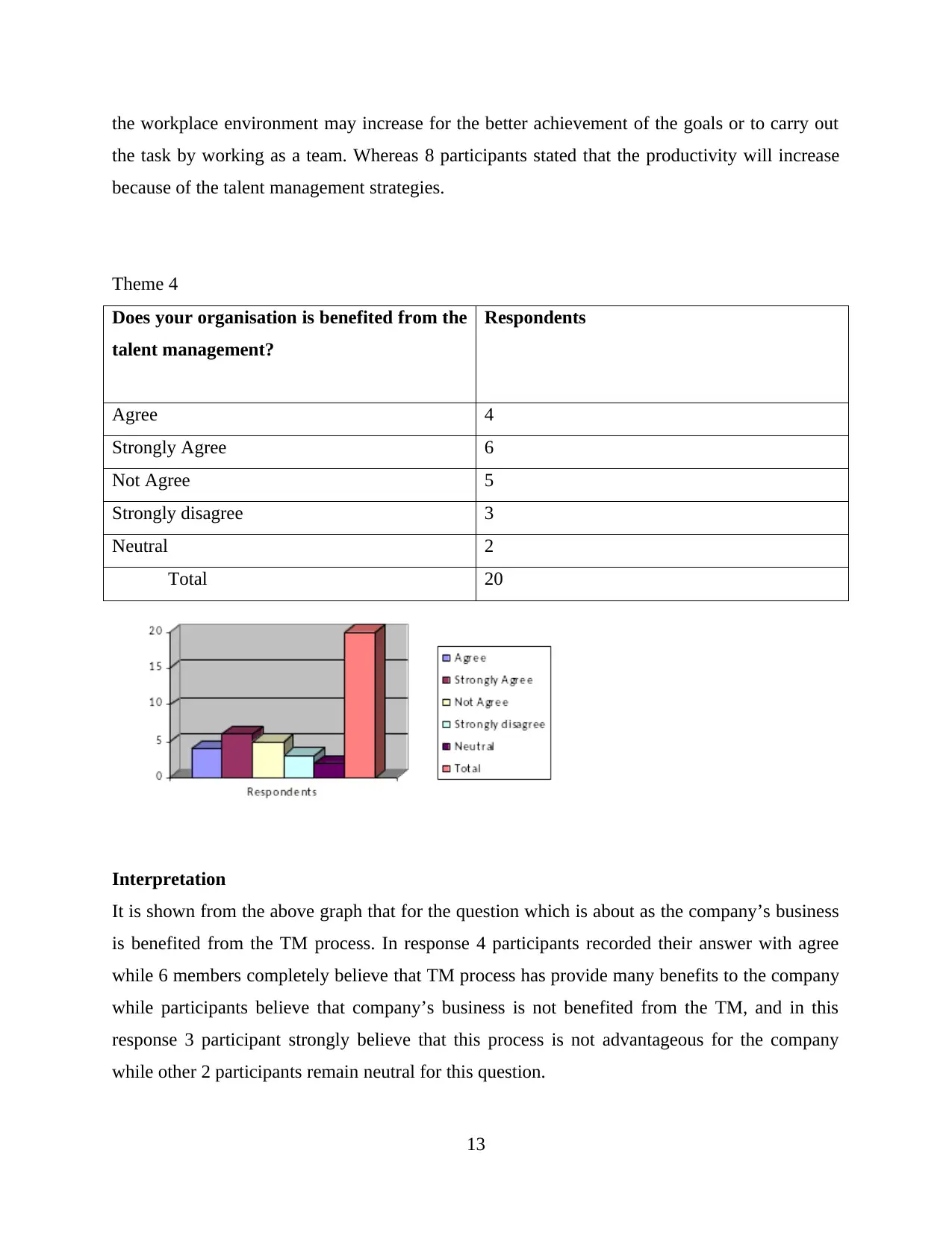
the workplace environment may increase for the better achievement of the goals or to carry out
the task by working as a team. Whereas 8 participants stated that the productivity will increase
because of the talent management strategies.
Theme 4
Does your organisation is benefited from the
talent management?
Respondents
Agree 4
Strongly Agree 6
Not Agree 5
Strongly disagree 3
Neutral 2
Total 20
Interpretation
It is shown from the above graph that for the question which is about as the company’s business
is benefited from the TM process. In response 4 participants recorded their answer with agree
while 6 members completely believe that TM process has provide many benefits to the company
while participants believe that company’s business is not benefited from the TM, and in this
response 3 participant strongly believe that this process is not advantageous for the company
while other 2 participants remain neutral for this question.
13
the task by working as a team. Whereas 8 participants stated that the productivity will increase
because of the talent management strategies.
Theme 4
Does your organisation is benefited from the
talent management?
Respondents
Agree 4
Strongly Agree 6
Not Agree 5
Strongly disagree 3
Neutral 2
Total 20
Interpretation
It is shown from the above graph that for the question which is about as the company’s business
is benefited from the TM process. In response 4 participants recorded their answer with agree
while 6 members completely believe that TM process has provide many benefits to the company
while participants believe that company’s business is not benefited from the TM, and in this
response 3 participant strongly believe that this process is not advantageous for the company
while other 2 participants remain neutral for this question.
13
Paraphrase This Document
Need a fresh take? Get an instant paraphrase of this document with our AI Paraphraser
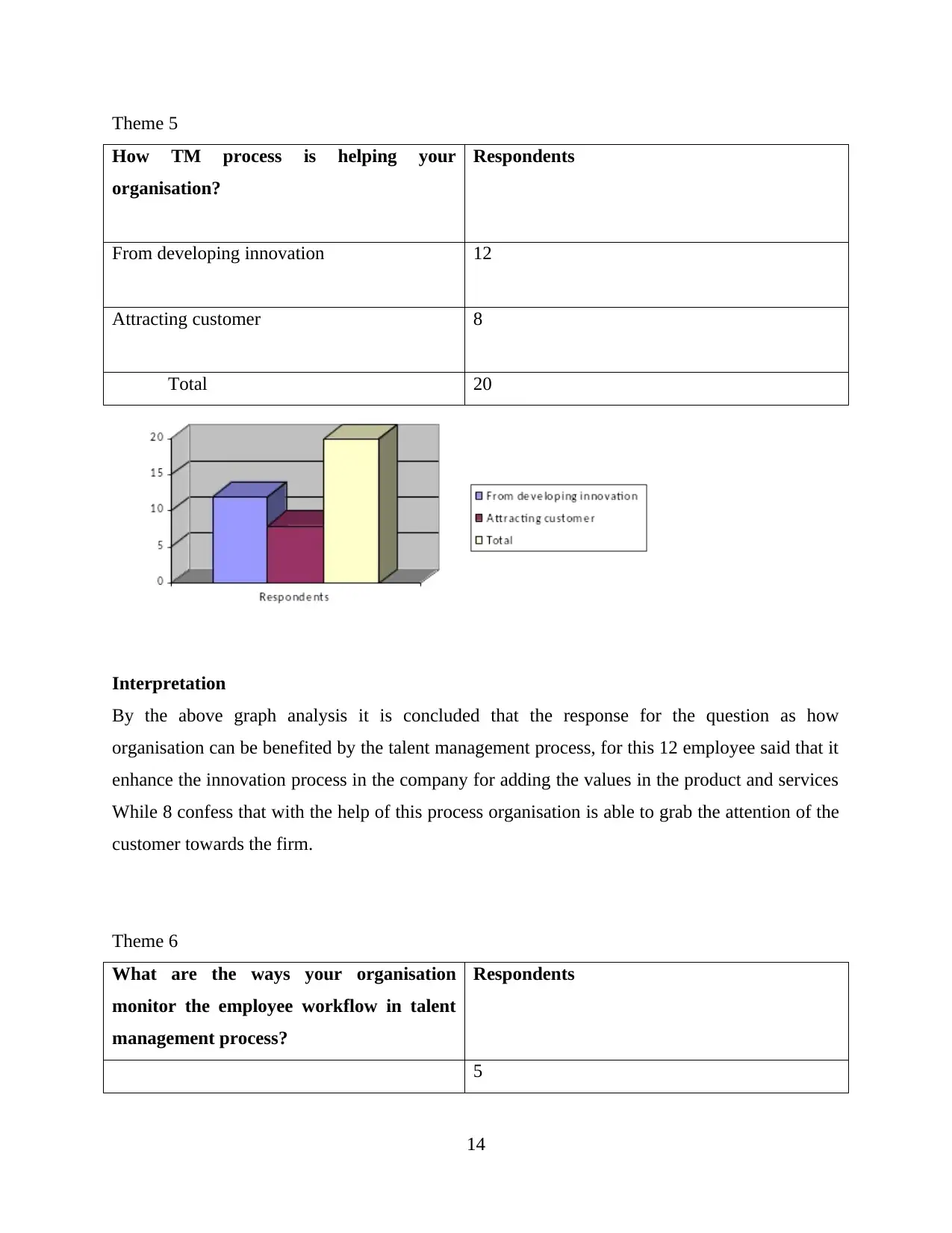
Theme 5
How TM process is helping your
organisation?
Respondents
From developing innovation 12
Attracting customer 8
Total 20
Interpretation
By the above graph analysis it is concluded that the response for the question as how
organisation can be benefited by the talent management process, for this 12 employee said that it
enhance the innovation process in the company for adding the values in the product and services
While 8 confess that with the help of this process organisation is able to grab the attention of the
customer towards the firm.
Theme 6
What are the ways your organisation
monitor the employee workflow in talent
management process?
Respondents
5
14
How TM process is helping your
organisation?
Respondents
From developing innovation 12
Attracting customer 8
Total 20
Interpretation
By the above graph analysis it is concluded that the response for the question as how
organisation can be benefited by the talent management process, for this 12 employee said that it
enhance the innovation process in the company for adding the values in the product and services
While 8 confess that with the help of this process organisation is able to grab the attention of the
customer towards the firm.
Theme 6
What are the ways your organisation
monitor the employee workflow in talent
management process?
Respondents
5
14

Planning
Organising
8
Selecting 7
Total 20
Interpretation
It is analysed from the above data in response to the question which is stated as to monitor the
employee work flow in the talent management, 5 have give their answer as with the planning the
tracking of the staff work flow can be monitor. 8 stated in response as organising is the better
way to manage the work flow, while 7 believes that the selection is the better way for
maintaining the data for the employee workflow within the talent management process.
Theme 7
Does your organisation have proper
resources to conduct the skill development
training for the employees?
Respondents
Yes
14
15
Organising
8
Selecting 7
Total 20
Interpretation
It is analysed from the above data in response to the question which is stated as to monitor the
employee work flow in the talent management, 5 have give their answer as with the planning the
tracking of the staff work flow can be monitor. 8 stated in response as organising is the better
way to manage the work flow, while 7 believes that the selection is the better way for
maintaining the data for the employee workflow within the talent management process.
Theme 7
Does your organisation have proper
resources to conduct the skill development
training for the employees?
Respondents
Yes
14
15

No 6
Total 20
Interpretation
It is illustrated from the above graphical representation that the question which the research
analyst asked to the participants of the organisation . it is based on the resources for the skill
development. In response to this question participants stated their different views over the
question, it is obvious that none of them have the same opinion. As 14 participants believes that
their organisation have the enough resources in order to provide the better skill development
resources. They strongly believe that their company believes in providing the training and skill
development programs for them, also stated that this type of training is done in a timely manner.
But other 6 participants completely disagree with their colleagues statement, as they have the
different opinion over the question. They conveys that their organisation do not have the
resources to conduct the skill development training for them.
Theme 8
Is your organisation have the policy to give
rewards to the employee for their good
work?
Respondents
5
16
Total 20
Interpretation
It is illustrated from the above graphical representation that the question which the research
analyst asked to the participants of the organisation . it is based on the resources for the skill
development. In response to this question participants stated their different views over the
question, it is obvious that none of them have the same opinion. As 14 participants believes that
their organisation have the enough resources in order to provide the better skill development
resources. They strongly believe that their company believes in providing the training and skill
development programs for them, also stated that this type of training is done in a timely manner.
But other 6 participants completely disagree with their colleagues statement, as they have the
different opinion over the question. They conveys that their organisation do not have the
resources to conduct the skill development training for them.
Theme 8
Is your organisation have the policy to give
rewards to the employee for their good
work?
Respondents
5
16
Secure Best Marks with AI Grader
Need help grading? Try our AI Grader for instant feedback on your assignments.
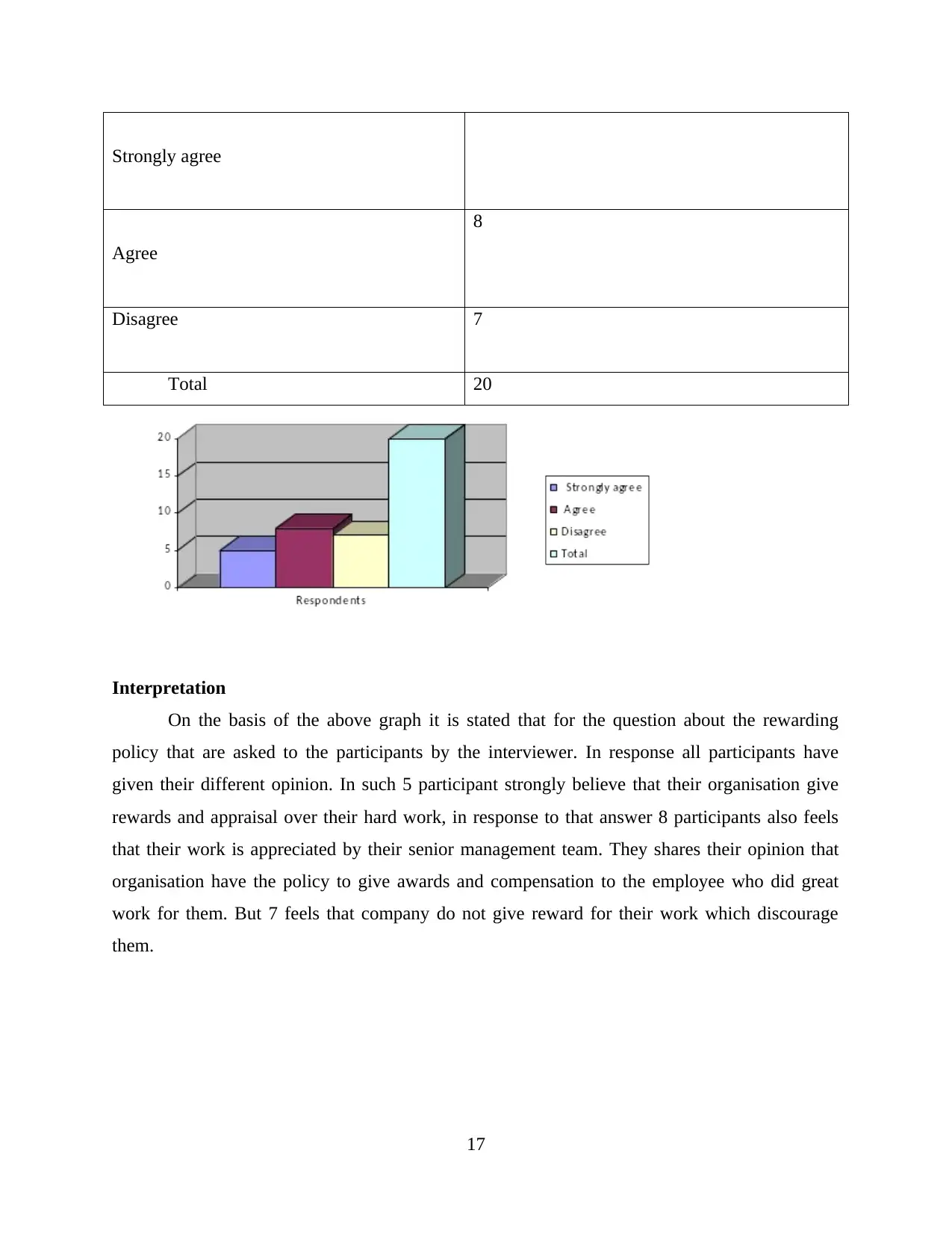
Strongly agree
Agree
8
Disagree 7
Total 20
Interpretation
On the basis of the above graph it is stated that for the question about the rewarding
policy that are asked to the participants by the interviewer. In response all participants have
given their different opinion. In such 5 participant strongly believe that their organisation give
rewards and appraisal over their hard work, in response to that answer 8 participants also feels
that their work is appreciated by their senior management team. They shares their opinion that
organisation have the policy to give awards and compensation to the employee who did great
work for them. But 7 feels that company do not give reward for their work which discourage
them.
17
Agree
8
Disagree 7
Total 20
Interpretation
On the basis of the above graph it is stated that for the question about the rewarding
policy that are asked to the participants by the interviewer. In response all participants have
given their different opinion. In such 5 participant strongly believe that their organisation give
rewards and appraisal over their hard work, in response to that answer 8 participants also feels
that their work is appreciated by their senior management team. They shares their opinion that
organisation have the policy to give awards and compensation to the employee who did great
work for them. But 7 feels that company do not give reward for their work which discourage
them.
17
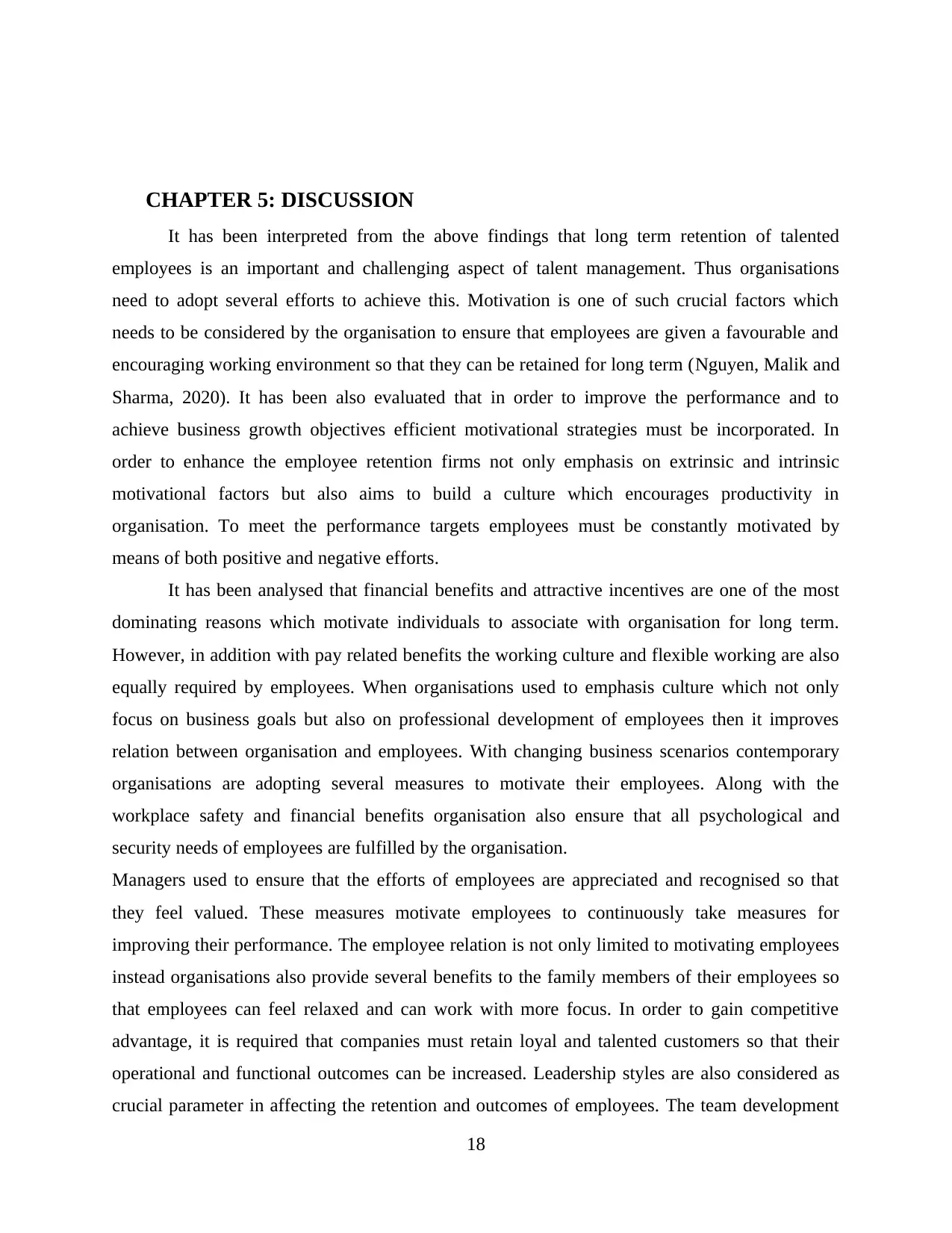
CHAPTER 5: DISCUSSION
It has been interpreted from the above findings that long term retention of talented
employees is an important and challenging aspect of talent management. Thus organisations
need to adopt several efforts to achieve this. Motivation is one of such crucial factors which
needs to be considered by the organisation to ensure that employees are given a favourable and
encouraging working environment so that they can be retained for long term (Nguyen, Malik and
Sharma, 2020). It has been also evaluated that in order to improve the performance and to
achieve business growth objectives efficient motivational strategies must be incorporated. In
order to enhance the employee retention firms not only emphasis on extrinsic and intrinsic
motivational factors but also aims to build a culture which encourages productivity in
organisation. To meet the performance targets employees must be constantly motivated by
means of both positive and negative efforts.
It has been analysed that financial benefits and attractive incentives are one of the most
dominating reasons which motivate individuals to associate with organisation for long term.
However, in addition with pay related benefits the working culture and flexible working are also
equally required by employees. When organisations used to emphasis culture which not only
focus on business goals but also on professional development of employees then it improves
relation between organisation and employees. With changing business scenarios contemporary
organisations are adopting several measures to motivate their employees. Along with the
workplace safety and financial benefits organisation also ensure that all psychological and
security needs of employees are fulfilled by the organisation.
Managers used to ensure that the efforts of employees are appreciated and recognised so that
they feel valued. These measures motivate employees to continuously take measures for
improving their performance. The employee relation is not only limited to motivating employees
instead organisations also provide several benefits to the family members of their employees so
that employees can feel relaxed and can work with more focus. In order to gain competitive
advantage, it is required that companies must retain loyal and talented customers so that their
operational and functional outcomes can be increased. Leadership styles are also considered as
crucial parameter in affecting the retention and outcomes of employees. The team development
18
It has been interpreted from the above findings that long term retention of talented
employees is an important and challenging aspect of talent management. Thus organisations
need to adopt several efforts to achieve this. Motivation is one of such crucial factors which
needs to be considered by the organisation to ensure that employees are given a favourable and
encouraging working environment so that they can be retained for long term (Nguyen, Malik and
Sharma, 2020). It has been also evaluated that in order to improve the performance and to
achieve business growth objectives efficient motivational strategies must be incorporated. In
order to enhance the employee retention firms not only emphasis on extrinsic and intrinsic
motivational factors but also aims to build a culture which encourages productivity in
organisation. To meet the performance targets employees must be constantly motivated by
means of both positive and negative efforts.
It has been analysed that financial benefits and attractive incentives are one of the most
dominating reasons which motivate individuals to associate with organisation for long term.
However, in addition with pay related benefits the working culture and flexible working are also
equally required by employees. When organisations used to emphasis culture which not only
focus on business goals but also on professional development of employees then it improves
relation between organisation and employees. With changing business scenarios contemporary
organisations are adopting several measures to motivate their employees. Along with the
workplace safety and financial benefits organisation also ensure that all psychological and
security needs of employees are fulfilled by the organisation.
Managers used to ensure that the efforts of employees are appreciated and recognised so that
they feel valued. These measures motivate employees to continuously take measures for
improving their performance. The employee relation is not only limited to motivating employees
instead organisations also provide several benefits to the family members of their employees so
that employees can feel relaxed and can work with more focus. In order to gain competitive
advantage, it is required that companies must retain loyal and talented customers so that their
operational and functional outcomes can be increased. Leadership styles are also considered as
crucial parameter in affecting the retention and outcomes of employees. The team development
18
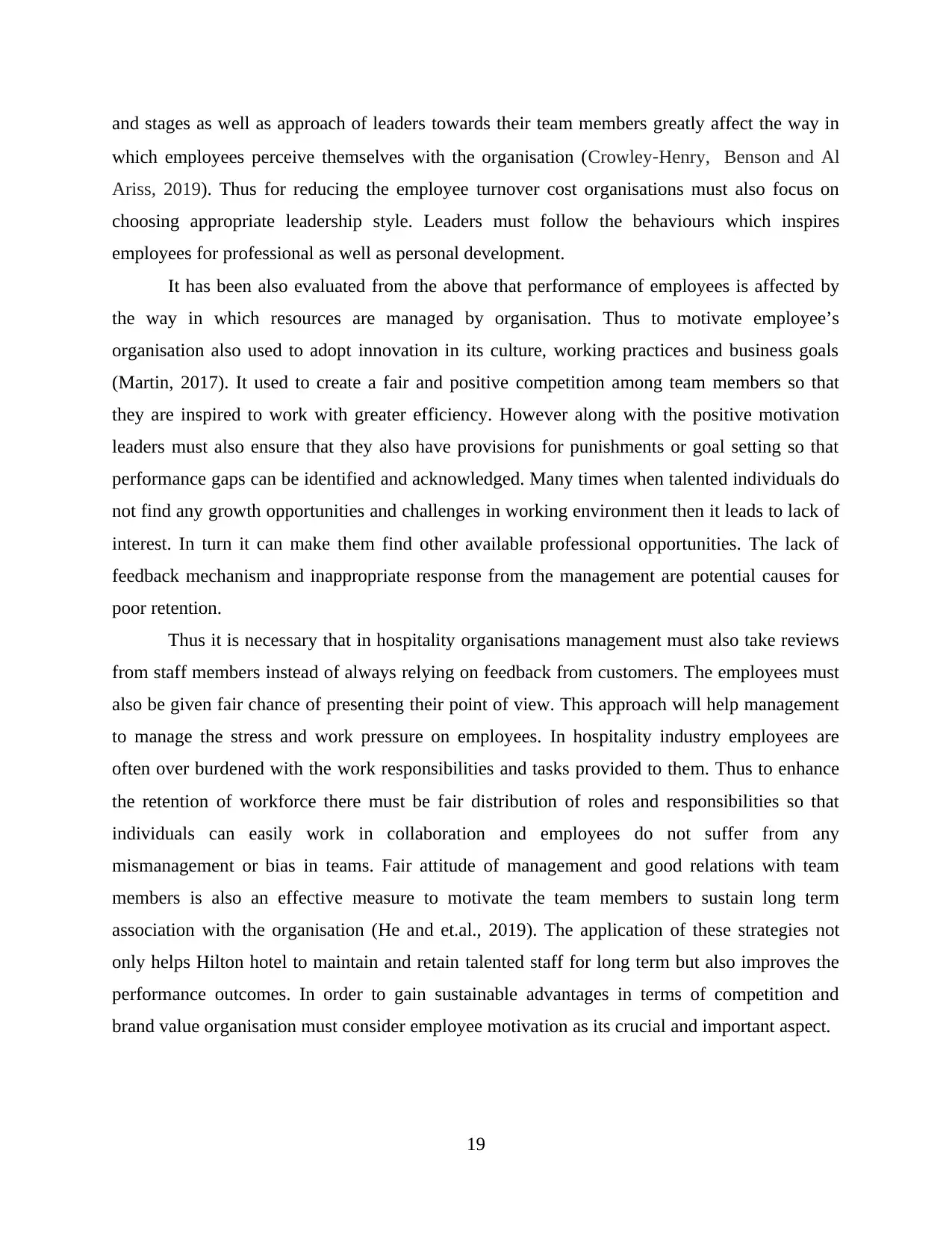
and stages as well as approach of leaders towards their team members greatly affect the way in
which employees perceive themselves with the organisation (Crowley‐Henry, Benson and Al
Ariss, 2019). Thus for reducing the employee turnover cost organisations must also focus on
choosing appropriate leadership style. Leaders must follow the behaviours which inspires
employees for professional as well as personal development.
It has been also evaluated from the above that performance of employees is affected by
the way in which resources are managed by organisation. Thus to motivate employee’s
organisation also used to adopt innovation in its culture, working practices and business goals
(Martin, 2017). It used to create a fair and positive competition among team members so that
they are inspired to work with greater efficiency. However along with the positive motivation
leaders must also ensure that they also have provisions for punishments or goal setting so that
performance gaps can be identified and acknowledged. Many times when talented individuals do
not find any growth opportunities and challenges in working environment then it leads to lack of
interest. In turn it can make them find other available professional opportunities. The lack of
feedback mechanism and inappropriate response from the management are potential causes for
poor retention.
Thus it is necessary that in hospitality organisations management must also take reviews
from staff members instead of always relying on feedback from customers. The employees must
also be given fair chance of presenting their point of view. This approach will help management
to manage the stress and work pressure on employees. In hospitality industry employees are
often over burdened with the work responsibilities and tasks provided to them. Thus to enhance
the retention of workforce there must be fair distribution of roles and responsibilities so that
individuals can easily work in collaboration and employees do not suffer from any
mismanagement or bias in teams. Fair attitude of management and good relations with team
members is also an effective measure to motivate the team members to sustain long term
association with the organisation (He and et.al., 2019). The application of these strategies not
only helps Hilton hotel to maintain and retain talented staff for long term but also improves the
performance outcomes. In order to gain sustainable advantages in terms of competition and
brand value organisation must consider employee motivation as its crucial and important aspect.
19
which employees perceive themselves with the organisation (Crowley‐Henry, Benson and Al
Ariss, 2019). Thus for reducing the employee turnover cost organisations must also focus on
choosing appropriate leadership style. Leaders must follow the behaviours which inspires
employees for professional as well as personal development.
It has been also evaluated from the above that performance of employees is affected by
the way in which resources are managed by organisation. Thus to motivate employee’s
organisation also used to adopt innovation in its culture, working practices and business goals
(Martin, 2017). It used to create a fair and positive competition among team members so that
they are inspired to work with greater efficiency. However along with the positive motivation
leaders must also ensure that they also have provisions for punishments or goal setting so that
performance gaps can be identified and acknowledged. Many times when talented individuals do
not find any growth opportunities and challenges in working environment then it leads to lack of
interest. In turn it can make them find other available professional opportunities. The lack of
feedback mechanism and inappropriate response from the management are potential causes for
poor retention.
Thus it is necessary that in hospitality organisations management must also take reviews
from staff members instead of always relying on feedback from customers. The employees must
also be given fair chance of presenting their point of view. This approach will help management
to manage the stress and work pressure on employees. In hospitality industry employees are
often over burdened with the work responsibilities and tasks provided to them. Thus to enhance
the retention of workforce there must be fair distribution of roles and responsibilities so that
individuals can easily work in collaboration and employees do not suffer from any
mismanagement or bias in teams. Fair attitude of management and good relations with team
members is also an effective measure to motivate the team members to sustain long term
association with the organisation (He and et.al., 2019). The application of these strategies not
only helps Hilton hotel to maintain and retain talented staff for long term but also improves the
performance outcomes. In order to gain sustainable advantages in terms of competition and
brand value organisation must consider employee motivation as its crucial and important aspect.
19
Paraphrase This Document
Need a fresh take? Get an instant paraphrase of this document with our AI Paraphraser
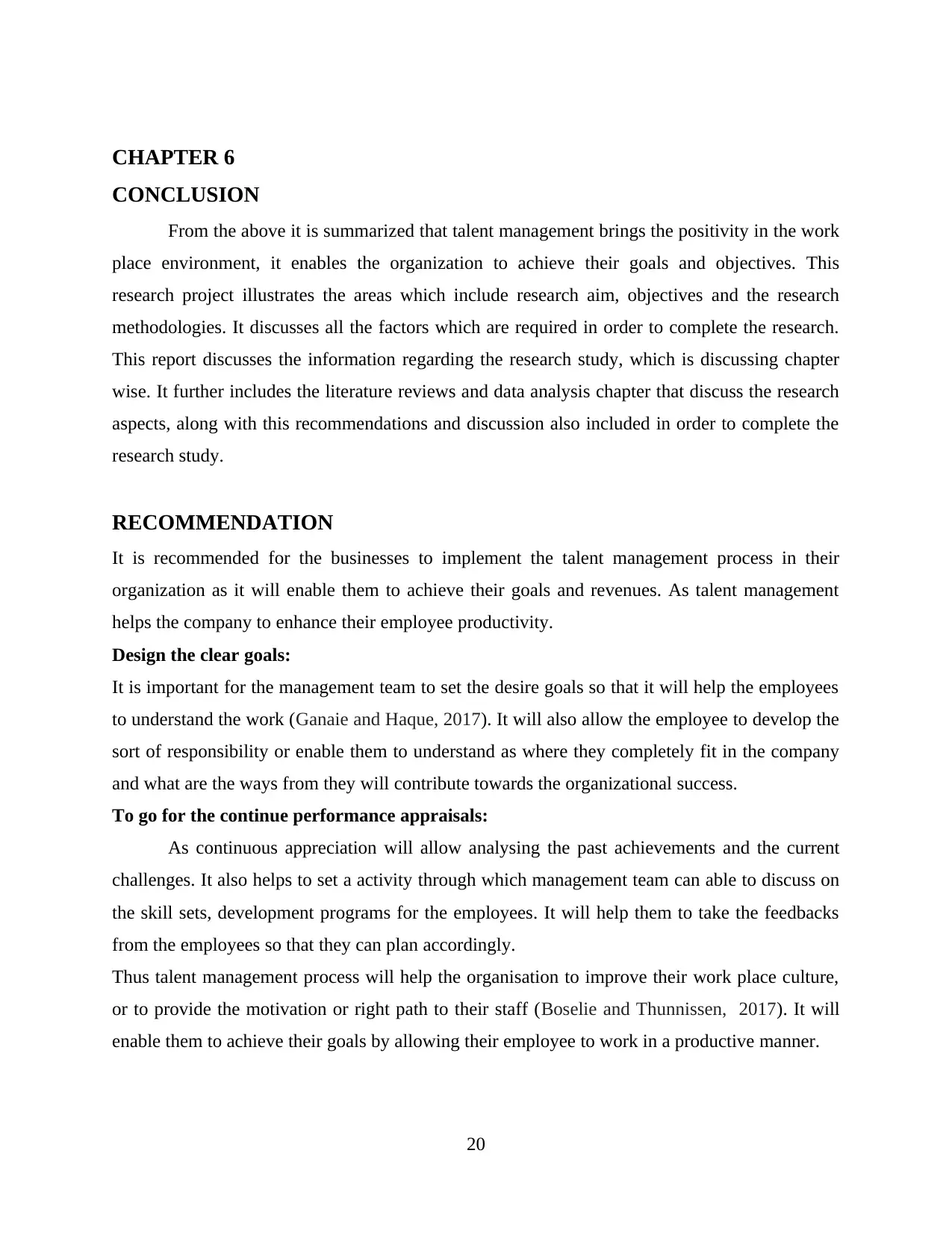
CHAPTER 6
CONCLUSION
From the above it is summarized that talent management brings the positivity in the work
place environment, it enables the organization to achieve their goals and objectives. This
research project illustrates the areas which include research aim, objectives and the research
methodologies. It discusses all the factors which are required in order to complete the research.
This report discusses the information regarding the research study, which is discussing chapter
wise. It further includes the literature reviews and data analysis chapter that discuss the research
aspects, along with this recommendations and discussion also included in order to complete the
research study.
RECOMMENDATION
It is recommended for the businesses to implement the talent management process in their
organization as it will enable them to achieve their goals and revenues. As talent management
helps the company to enhance their employee productivity.
Design the clear goals:
It is important for the management team to set the desire goals so that it will help the employees
to understand the work (Ganaie and Haque, 2017). It will also allow the employee to develop the
sort of responsibility or enable them to understand as where they completely fit in the company
and what are the ways from they will contribute towards the organizational success.
To go for the continue performance appraisals:
As continuous appreciation will allow analysing the past achievements and the current
challenges. It also helps to set a activity through which management team can able to discuss on
the skill sets, development programs for the employees. It will help them to take the feedbacks
from the employees so that they can plan accordingly.
Thus talent management process will help the organisation to improve their work place culture,
or to provide the motivation or right path to their staff (Boselie and Thunnissen, 2017). It will
enable them to achieve their goals by allowing their employee to work in a productive manner.
20
CONCLUSION
From the above it is summarized that talent management brings the positivity in the work
place environment, it enables the organization to achieve their goals and objectives. This
research project illustrates the areas which include research aim, objectives and the research
methodologies. It discusses all the factors which are required in order to complete the research.
This report discusses the information regarding the research study, which is discussing chapter
wise. It further includes the literature reviews and data analysis chapter that discuss the research
aspects, along with this recommendations and discussion also included in order to complete the
research study.
RECOMMENDATION
It is recommended for the businesses to implement the talent management process in their
organization as it will enable them to achieve their goals and revenues. As talent management
helps the company to enhance their employee productivity.
Design the clear goals:
It is important for the management team to set the desire goals so that it will help the employees
to understand the work (Ganaie and Haque, 2017). It will also allow the employee to develop the
sort of responsibility or enable them to understand as where they completely fit in the company
and what are the ways from they will contribute towards the organizational success.
To go for the continue performance appraisals:
As continuous appreciation will allow analysing the past achievements and the current
challenges. It also helps to set a activity through which management team can able to discuss on
the skill sets, development programs for the employees. It will help them to take the feedbacks
from the employees so that they can plan accordingly.
Thus talent management process will help the organisation to improve their work place culture,
or to provide the motivation or right path to their staff (Boselie and Thunnissen, 2017). It will
enable them to achieve their goals by allowing their employee to work in a productive manner.
20
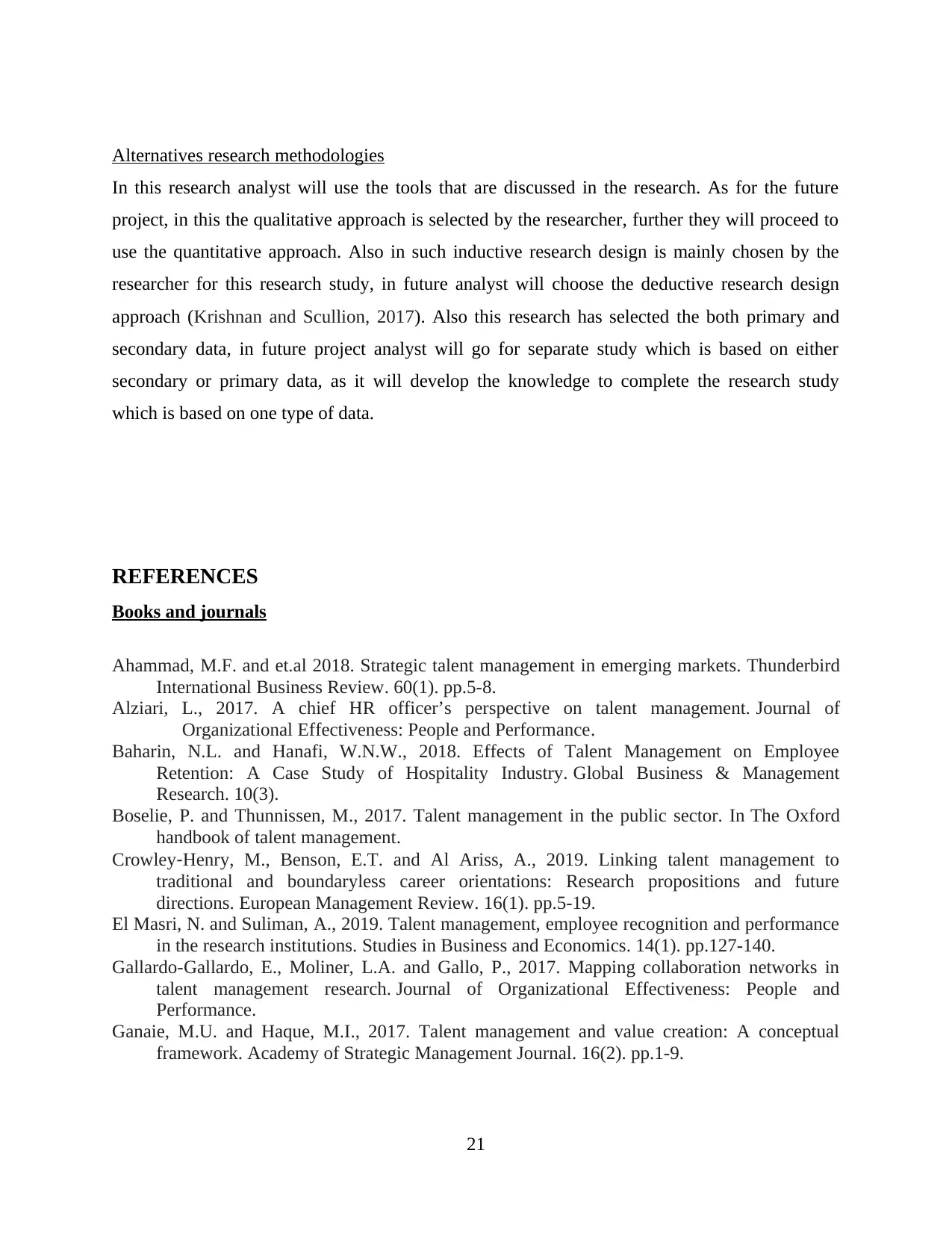
Alternatives research methodologies
In this research analyst will use the tools that are discussed in the research. As for the future
project, in this the qualitative approach is selected by the researcher, further they will proceed to
use the quantitative approach. Also in such inductive research design is mainly chosen by the
researcher for this research study, in future analyst will choose the deductive research design
approach (Krishnan and Scullion, 2017). Also this research has selected the both primary and
secondary data, in future project analyst will go for separate study which is based on either
secondary or primary data, as it will develop the knowledge to complete the research study
which is based on one type of data.
REFERENCES
Books and journals
Ahammad, M.F. and et.al 2018. Strategic talent management in emerging markets. Thunderbird
International Business Review. 60(1). pp.5-8.
Alziari, L., 2017. A chief HR officer’s perspective on talent management. Journal of
Organizational Effectiveness: People and Performance.
Baharin, N.L. and Hanafi, W.N.W., 2018. Effects of Talent Management on Employee
Retention: A Case Study of Hospitality Industry. Global Business & Management
Research. 10(3).
Boselie, P. and Thunnissen, M., 2017. Talent management in the public sector. In The Oxford
handbook of talent management.
Crowley‐Henry, M., Benson, E.T. and Al Ariss, A., 2019. Linking talent management to
traditional and boundaryless career orientations: Research propositions and future
directions. European Management Review. 16(1). pp.5-19.
El Masri, N. and Suliman, A., 2019. Talent management, employee recognition and performance
in the research institutions. Studies in Business and Economics. 14(1). pp.127-140.
Gallardo-Gallardo, E., Moliner, L.A. and Gallo, P., 2017. Mapping collaboration networks in
talent management research. Journal of Organizational Effectiveness: People and
Performance.
Ganaie, M.U. and Haque, M.I., 2017. Talent management and value creation: A conceptual
framework. Academy of Strategic Management Journal. 16(2). pp.1-9.
21
In this research analyst will use the tools that are discussed in the research. As for the future
project, in this the qualitative approach is selected by the researcher, further they will proceed to
use the quantitative approach. Also in such inductive research design is mainly chosen by the
researcher for this research study, in future analyst will choose the deductive research design
approach (Krishnan and Scullion, 2017). Also this research has selected the both primary and
secondary data, in future project analyst will go for separate study which is based on either
secondary or primary data, as it will develop the knowledge to complete the research study
which is based on one type of data.
REFERENCES
Books and journals
Ahammad, M.F. and et.al 2018. Strategic talent management in emerging markets. Thunderbird
International Business Review. 60(1). pp.5-8.
Alziari, L., 2017. A chief HR officer’s perspective on talent management. Journal of
Organizational Effectiveness: People and Performance.
Baharin, N.L. and Hanafi, W.N.W., 2018. Effects of Talent Management on Employee
Retention: A Case Study of Hospitality Industry. Global Business & Management
Research. 10(3).
Boselie, P. and Thunnissen, M., 2017. Talent management in the public sector. In The Oxford
handbook of talent management.
Crowley‐Henry, M., Benson, E.T. and Al Ariss, A., 2019. Linking talent management to
traditional and boundaryless career orientations: Research propositions and future
directions. European Management Review. 16(1). pp.5-19.
El Masri, N. and Suliman, A., 2019. Talent management, employee recognition and performance
in the research institutions. Studies in Business and Economics. 14(1). pp.127-140.
Gallardo-Gallardo, E., Moliner, L.A. and Gallo, P., 2017. Mapping collaboration networks in
talent management research. Journal of Organizational Effectiveness: People and
Performance.
Ganaie, M.U. and Haque, M.I., 2017. Talent management and value creation: A conceptual
framework. Academy of Strategic Management Journal. 16(2). pp.1-9.
21
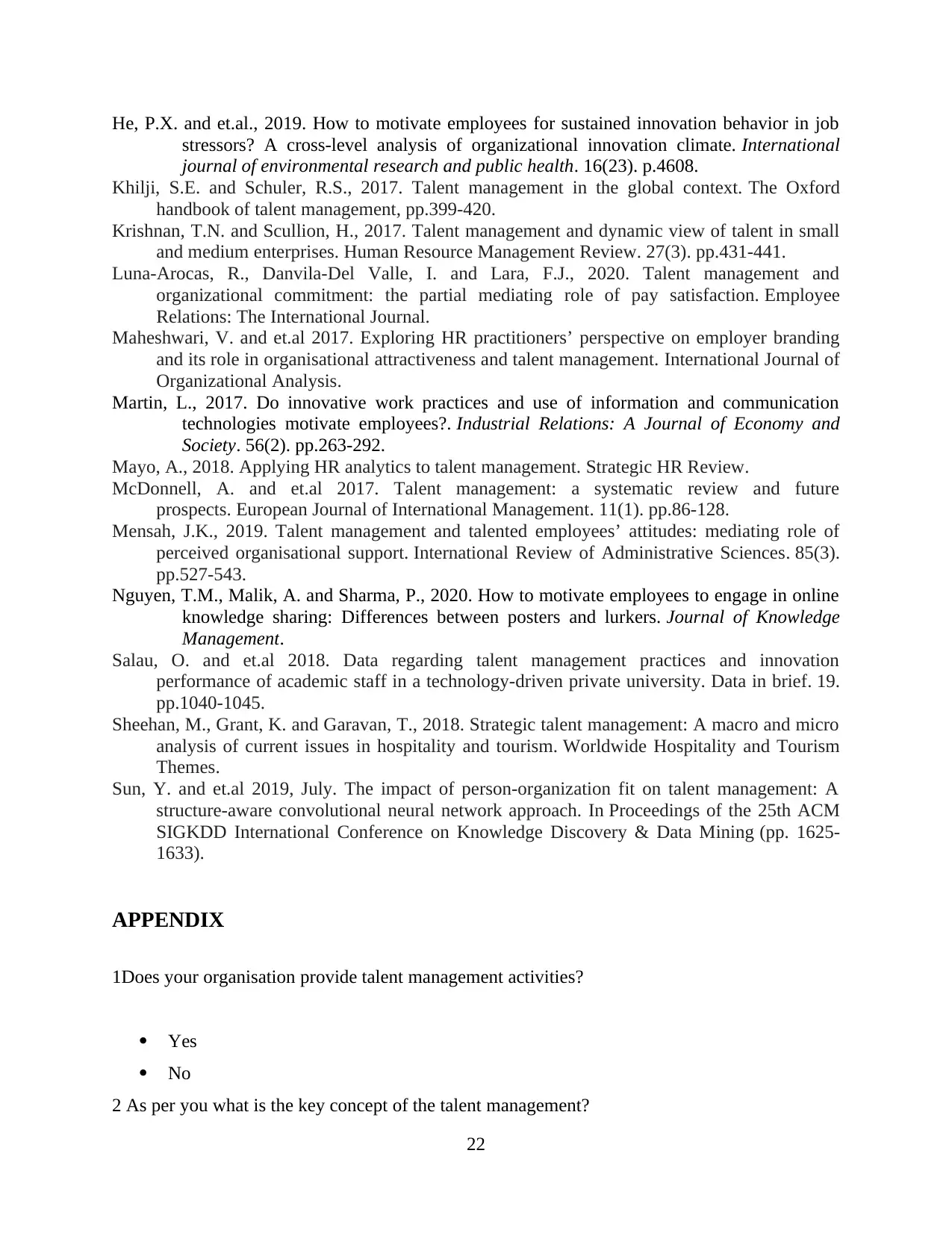
He, P.X. and et.al., 2019. How to motivate employees for sustained innovation behavior in job
stressors? A cross-level analysis of organizational innovation climate. International
journal of environmental research and public health. 16(23). p.4608.
Khilji, S.E. and Schuler, R.S., 2017. Talent management in the global context. The Oxford
handbook of talent management, pp.399-420.
Krishnan, T.N. and Scullion, H., 2017. Talent management and dynamic view of talent in small
and medium enterprises. Human Resource Management Review. 27(3). pp.431-441.
Luna-Arocas, R., Danvila-Del Valle, I. and Lara, F.J., 2020. Talent management and
organizational commitment: the partial mediating role of pay satisfaction. Employee
Relations: The International Journal.
Maheshwari, V. and et.al 2017. Exploring HR practitioners’ perspective on employer branding
and its role in organisational attractiveness and talent management. International Journal of
Organizational Analysis.
Martin, L., 2017. Do innovative work practices and use of information and communication
technologies motivate employees?. Industrial Relations: A Journal of Economy and
Society. 56(2). pp.263-292.
Mayo, A., 2018. Applying HR analytics to talent management. Strategic HR Review.
McDonnell, A. and et.al 2017. Talent management: a systematic review and future
prospects. European Journal of International Management. 11(1). pp.86-128.
Mensah, J.K., 2019. Talent management and talented employees’ attitudes: mediating role of
perceived organisational support. International Review of Administrative Sciences. 85(3).
pp.527-543.
Nguyen, T.M., Malik, A. and Sharma, P., 2020. How to motivate employees to engage in online
knowledge sharing: Differences between posters and lurkers. Journal of Knowledge
Management.
Salau, O. and et.al 2018. Data regarding talent management practices and innovation
performance of academic staff in a technology-driven private university. Data in brief. 19.
pp.1040-1045.
Sheehan, M., Grant, K. and Garavan, T., 2018. Strategic talent management: A macro and micro
analysis of current issues in hospitality and tourism. Worldwide Hospitality and Tourism
Themes.
Sun, Y. and et.al 2019, July. The impact of person-organization fit on talent management: A
structure-aware convolutional neural network approach. In Proceedings of the 25th ACM
SIGKDD International Conference on Knowledge Discovery & Data Mining (pp. 1625-
1633).
APPENDIX
1Does your organisation provide talent management activities?
Yes
No
2 As per you what is the key concept of the talent management?
22
stressors? A cross-level analysis of organizational innovation climate. International
journal of environmental research and public health. 16(23). p.4608.
Khilji, S.E. and Schuler, R.S., 2017. Talent management in the global context. The Oxford
handbook of talent management, pp.399-420.
Krishnan, T.N. and Scullion, H., 2017. Talent management and dynamic view of talent in small
and medium enterprises. Human Resource Management Review. 27(3). pp.431-441.
Luna-Arocas, R., Danvila-Del Valle, I. and Lara, F.J., 2020. Talent management and
organizational commitment: the partial mediating role of pay satisfaction. Employee
Relations: The International Journal.
Maheshwari, V. and et.al 2017. Exploring HR practitioners’ perspective on employer branding
and its role in organisational attractiveness and talent management. International Journal of
Organizational Analysis.
Martin, L., 2017. Do innovative work practices and use of information and communication
technologies motivate employees?. Industrial Relations: A Journal of Economy and
Society. 56(2). pp.263-292.
Mayo, A., 2018. Applying HR analytics to talent management. Strategic HR Review.
McDonnell, A. and et.al 2017. Talent management: a systematic review and future
prospects. European Journal of International Management. 11(1). pp.86-128.
Mensah, J.K., 2019. Talent management and talented employees’ attitudes: mediating role of
perceived organisational support. International Review of Administrative Sciences. 85(3).
pp.527-543.
Nguyen, T.M., Malik, A. and Sharma, P., 2020. How to motivate employees to engage in online
knowledge sharing: Differences between posters and lurkers. Journal of Knowledge
Management.
Salau, O. and et.al 2018. Data regarding talent management practices and innovation
performance of academic staff in a technology-driven private university. Data in brief. 19.
pp.1040-1045.
Sheehan, M., Grant, K. and Garavan, T., 2018. Strategic talent management: A macro and micro
analysis of current issues in hospitality and tourism. Worldwide Hospitality and Tourism
Themes.
Sun, Y. and et.al 2019, July. The impact of person-organization fit on talent management: A
structure-aware convolutional neural network approach. In Proceedings of the 25th ACM
SIGKDD International Conference on Knowledge Discovery & Data Mining (pp. 1625-
1633).
APPENDIX
1Does your organisation provide talent management activities?
Yes
No
2 As per you what is the key concept of the talent management?
22
Secure Best Marks with AI Grader
Need help grading? Try our AI Grader for instant feedback on your assignments.
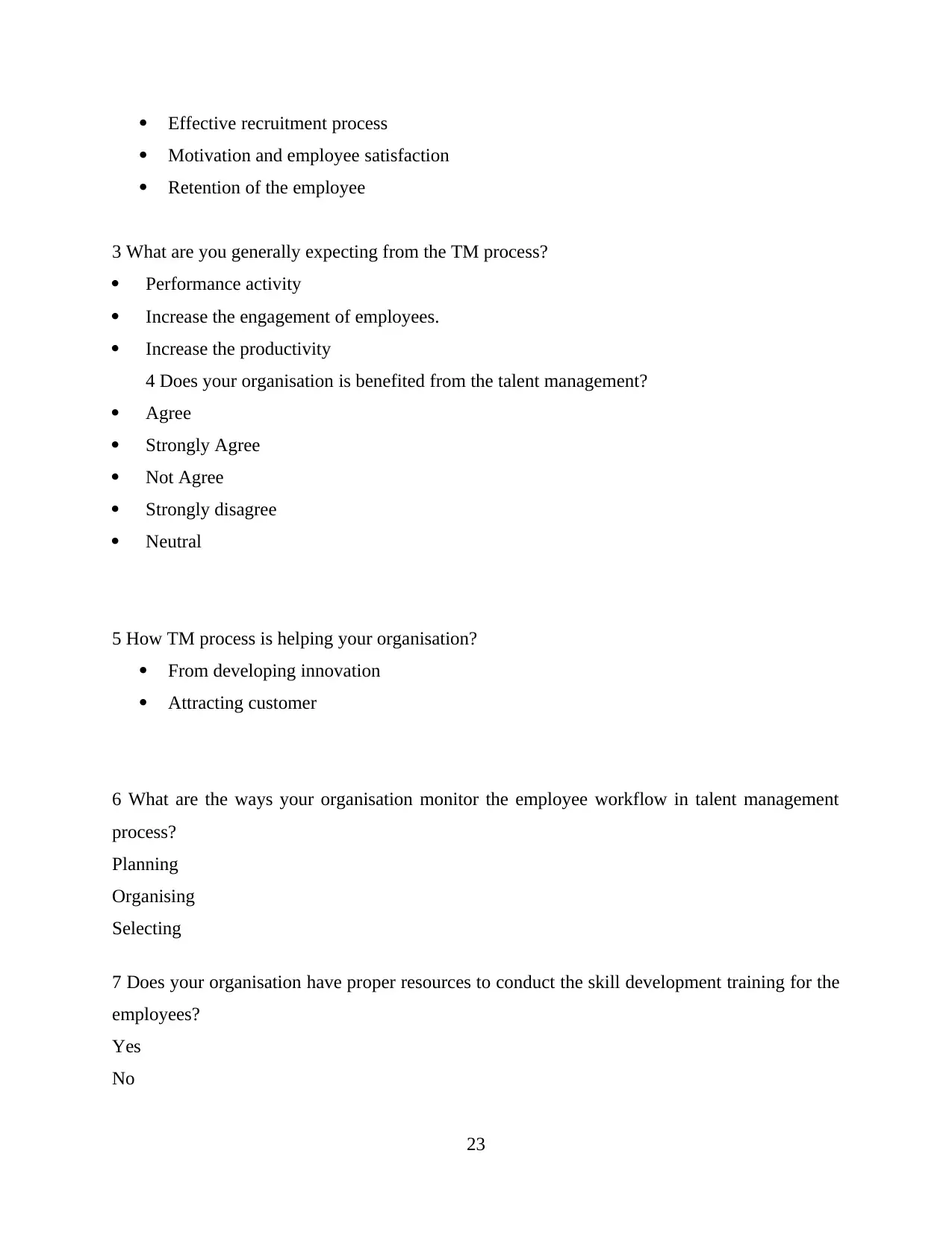
Effective recruitment process
Motivation and employee satisfaction
Retention of the employee
3 What are you generally expecting from the TM process?
Performance activity
Increase the engagement of employees.
Increase the productivity
4 Does your organisation is benefited from the talent management?
Agree
Strongly Agree
Not Agree
Strongly disagree
Neutral
5 How TM process is helping your organisation?
From developing innovation
Attracting customer
6 What are the ways your organisation monitor the employee workflow in talent management
process?
Planning
Organising
Selecting
7 Does your organisation have proper resources to conduct the skill development training for the
employees?
Yes
No
23
Motivation and employee satisfaction
Retention of the employee
3 What are you generally expecting from the TM process?
Performance activity
Increase the engagement of employees.
Increase the productivity
4 Does your organisation is benefited from the talent management?
Agree
Strongly Agree
Not Agree
Strongly disagree
Neutral
5 How TM process is helping your organisation?
From developing innovation
Attracting customer
6 What are the ways your organisation monitor the employee workflow in talent management
process?
Planning
Organising
Selecting
7 Does your organisation have proper resources to conduct the skill development training for the
employees?
Yes
No
23
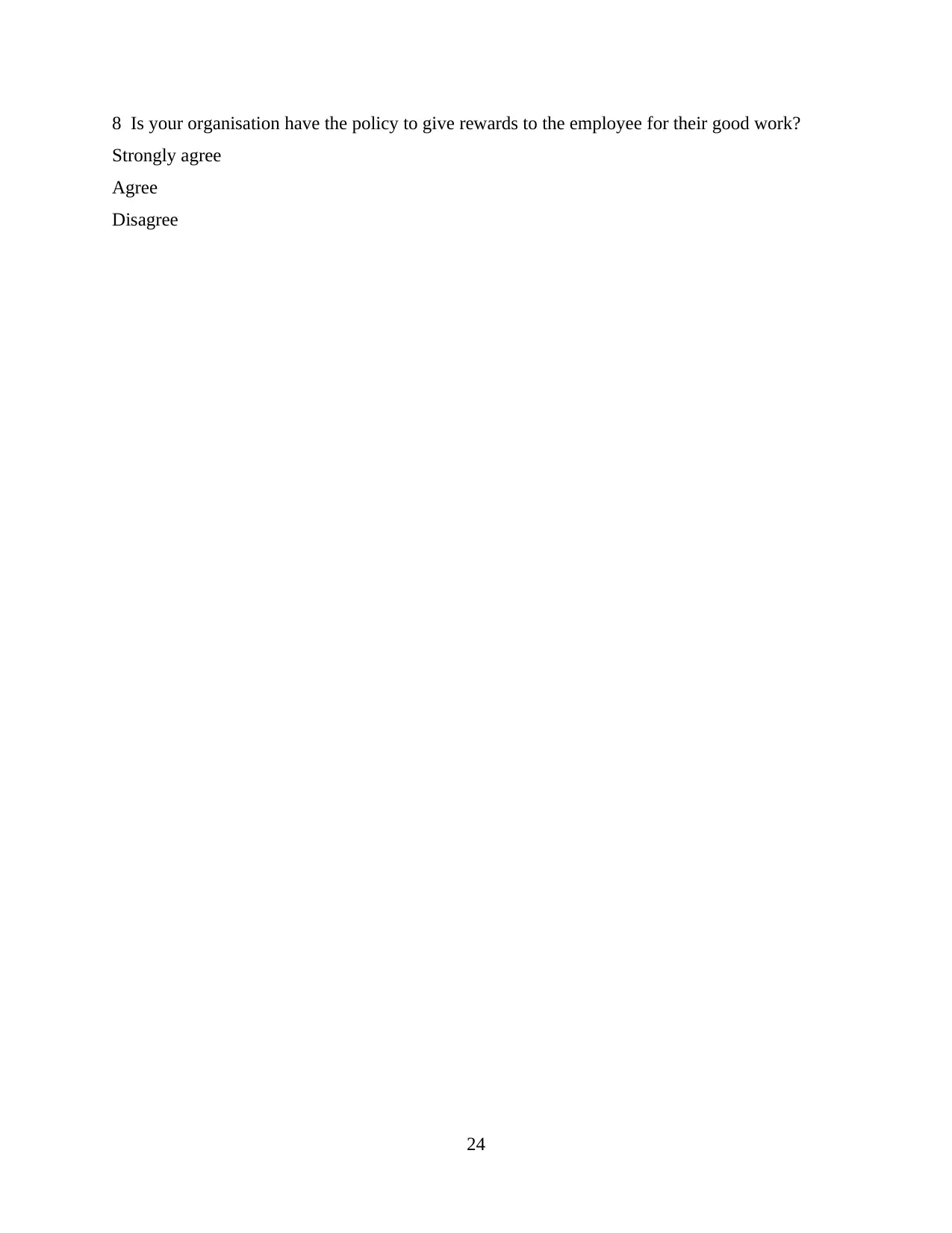
8 Is your organisation have the policy to give rewards to the employee for their good work?
Strongly agree
Agree
Disagree
24
Strongly agree
Agree
Disagree
24
1 out of 24
Related Documents
Your All-in-One AI-Powered Toolkit for Academic Success.
+13062052269
info@desklib.com
Available 24*7 on WhatsApp / Email
![[object Object]](/_next/static/media/star-bottom.7253800d.svg)
Unlock your academic potential
© 2024 | Zucol Services PVT LTD | All rights reserved.




